Information Systems Management Report
VerifiedAdded on 2022/08/22
|19
|5064
|14
AI Summary
Contribute Materials
Your contribution can guide someone’s learning journey. Share your
documents today.
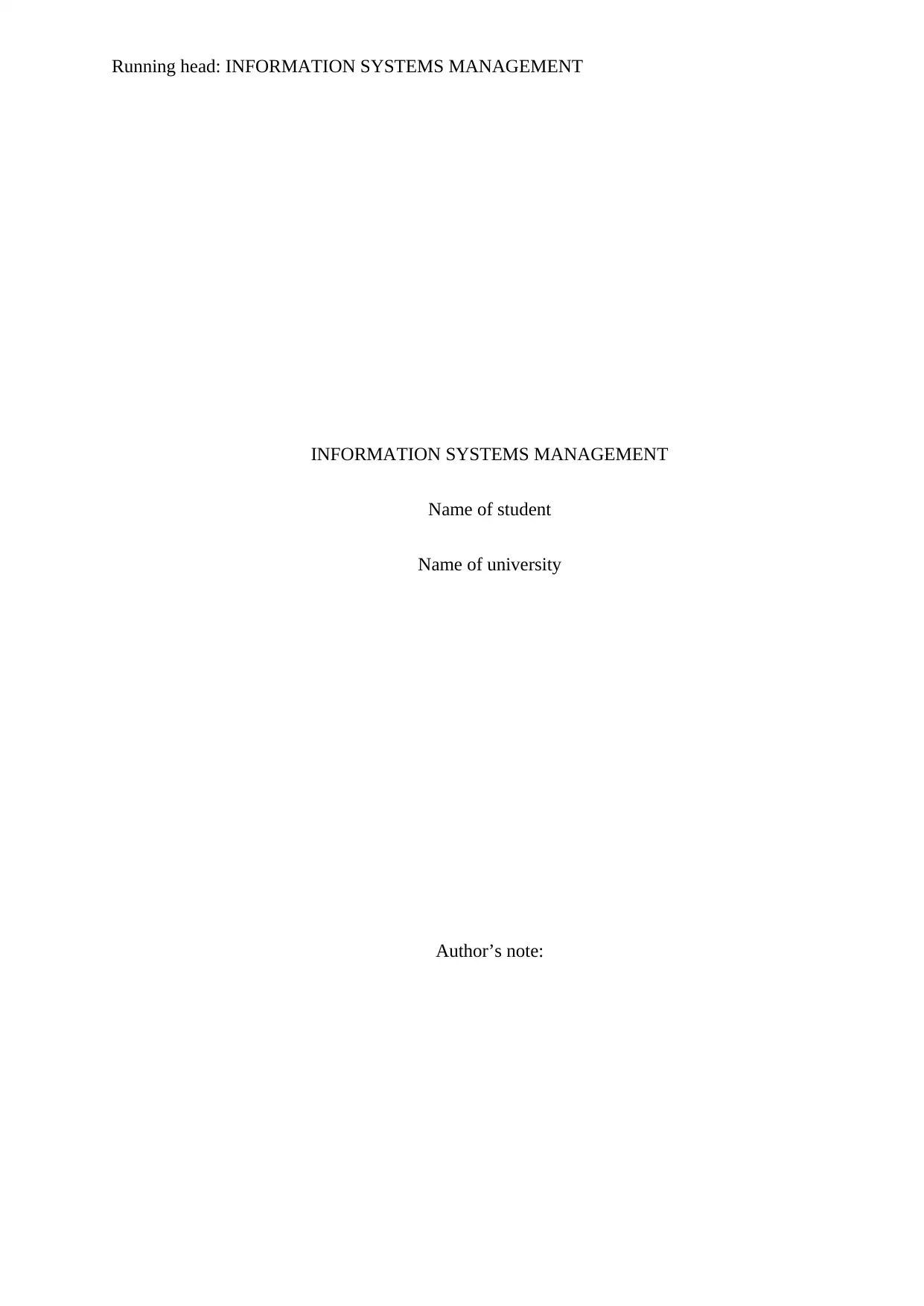
Running head: INFORMATION SYSTEMS MANAGEMENT
INFORMATION SYSTEMS MANAGEMENT
Name of student
Name of university
Author’s note:
INFORMATION SYSTEMS MANAGEMENT
Name of student
Name of university
Author’s note:
Secure Best Marks with AI Grader
Need help grading? Try our AI Grader for instant feedback on your assignments.
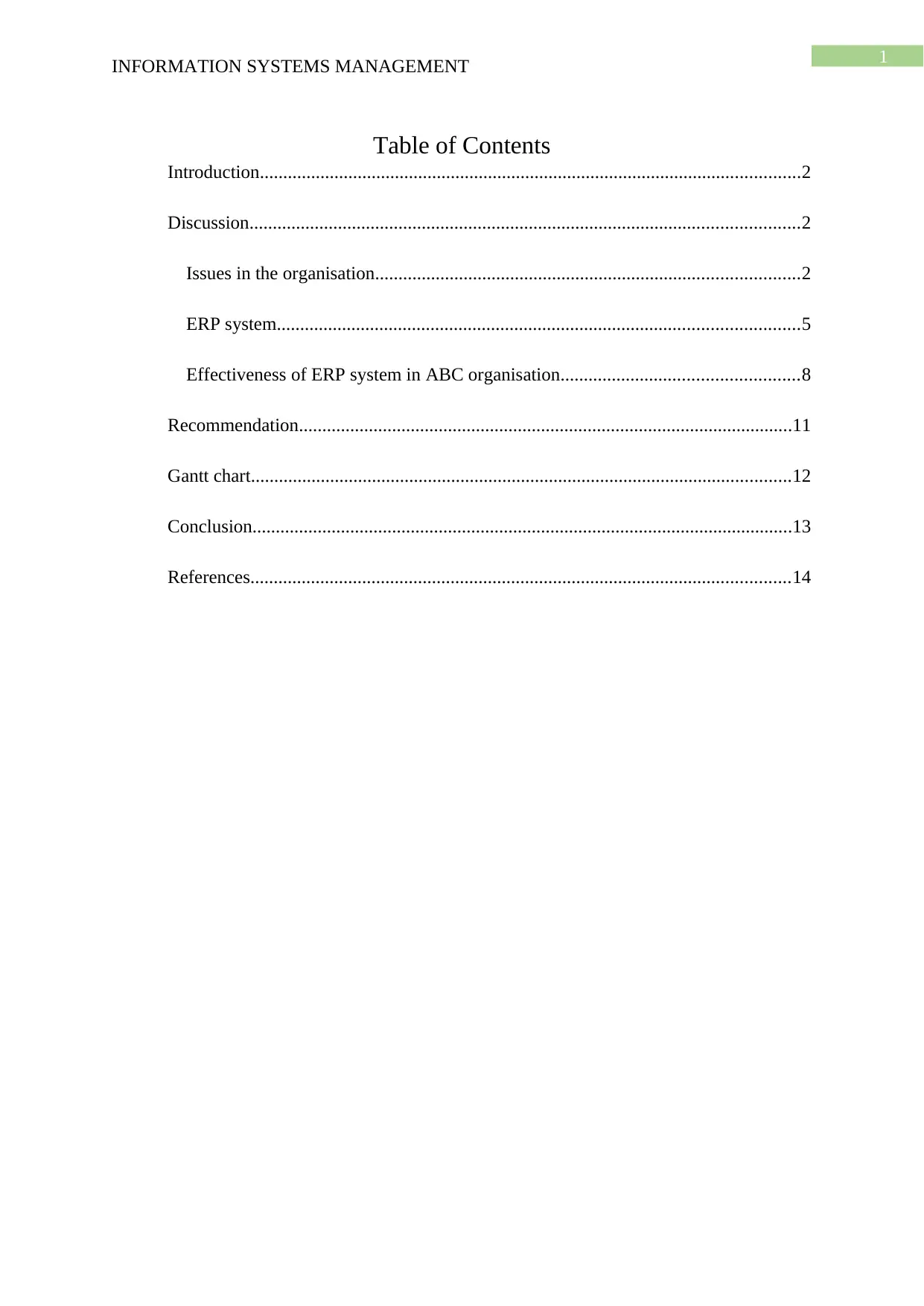
1
INFORMATION SYSTEMS MANAGEMENT
Table of Contents
Introduction....................................................................................................................2
Discussion......................................................................................................................2
Issues in the organisation...........................................................................................2
ERP system................................................................................................................5
Effectiveness of ERP system in ABC organisation...................................................8
Recommendation..........................................................................................................11
Gantt chart....................................................................................................................12
Conclusion....................................................................................................................13
References....................................................................................................................14
INFORMATION SYSTEMS MANAGEMENT
Table of Contents
Introduction....................................................................................................................2
Discussion......................................................................................................................2
Issues in the organisation...........................................................................................2
ERP system................................................................................................................5
Effectiveness of ERP system in ABC organisation...................................................8
Recommendation..........................................................................................................11
Gantt chart....................................................................................................................12
Conclusion....................................................................................................................13
References....................................................................................................................14
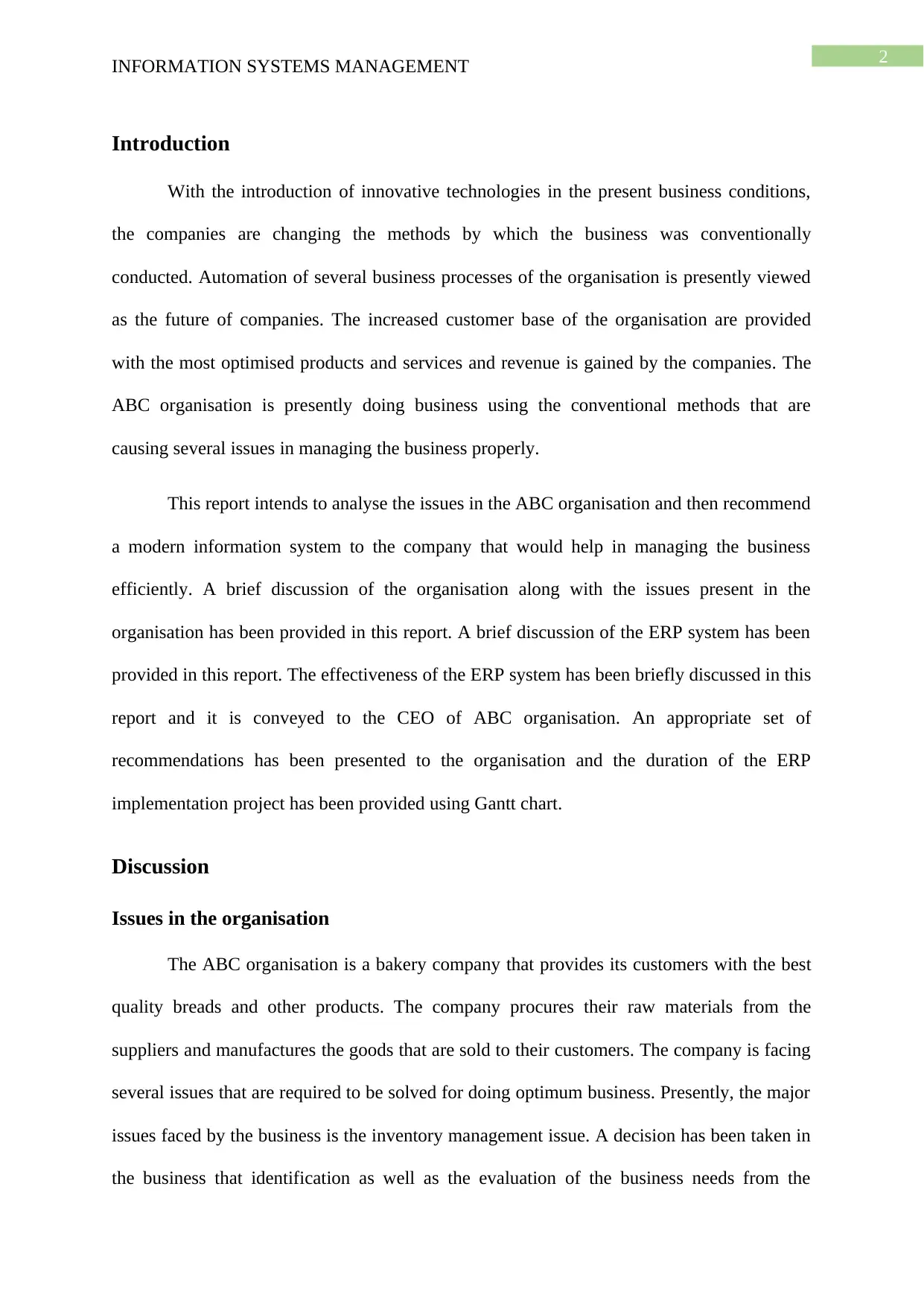
2
INFORMATION SYSTEMS MANAGEMENT
Introduction
With the introduction of innovative technologies in the present business conditions,
the companies are changing the methods by which the business was conventionally
conducted. Automation of several business processes of the organisation is presently viewed
as the future of companies. The increased customer base of the organisation are provided
with the most optimised products and services and revenue is gained by the companies. The
ABC organisation is presently doing business using the conventional methods that are
causing several issues in managing the business properly.
This report intends to analyse the issues in the ABC organisation and then recommend
a modern information system to the company that would help in managing the business
efficiently. A brief discussion of the organisation along with the issues present in the
organisation has been provided in this report. A brief discussion of the ERP system has been
provided in this report. The effectiveness of the ERP system has been briefly discussed in this
report and it is conveyed to the CEO of ABC organisation. An appropriate set of
recommendations has been presented to the organisation and the duration of the ERP
implementation project has been provided using Gantt chart.
Discussion
Issues in the organisation
The ABC organisation is a bakery company that provides its customers with the best
quality breads and other products. The company procures their raw materials from the
suppliers and manufactures the goods that are sold to their customers. The company is facing
several issues that are required to be solved for doing optimum business. Presently, the major
issues faced by the business is the inventory management issue. A decision has been taken in
the business that identification as well as the evaluation of the business needs from the
INFORMATION SYSTEMS MANAGEMENT
Introduction
With the introduction of innovative technologies in the present business conditions,
the companies are changing the methods by which the business was conventionally
conducted. Automation of several business processes of the organisation is presently viewed
as the future of companies. The increased customer base of the organisation are provided
with the most optimised products and services and revenue is gained by the companies. The
ABC organisation is presently doing business using the conventional methods that are
causing several issues in managing the business properly.
This report intends to analyse the issues in the ABC organisation and then recommend
a modern information system to the company that would help in managing the business
efficiently. A brief discussion of the organisation along with the issues present in the
organisation has been provided in this report. A brief discussion of the ERP system has been
provided in this report. The effectiveness of the ERP system has been briefly discussed in this
report and it is conveyed to the CEO of ABC organisation. An appropriate set of
recommendations has been presented to the organisation and the duration of the ERP
implementation project has been provided using Gantt chart.
Discussion
Issues in the organisation
The ABC organisation is a bakery company that provides its customers with the best
quality breads and other products. The company procures their raw materials from the
suppliers and manufactures the goods that are sold to their customers. The company is facing
several issues that are required to be solved for doing optimum business. Presently, the major
issues faced by the business is the inventory management issue. A decision has been taken in
the business that identification as well as the evaluation of the business needs from the
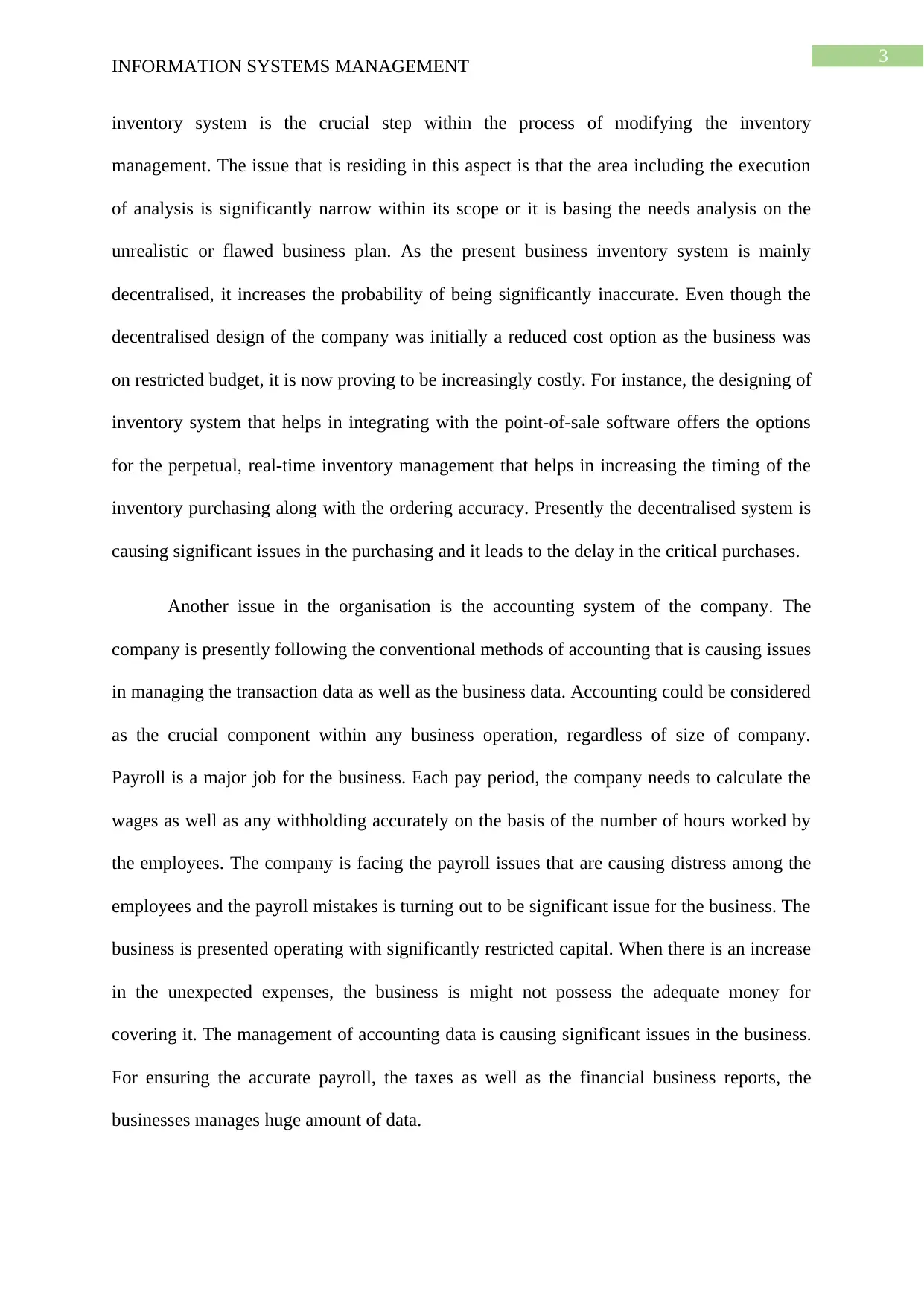
3
INFORMATION SYSTEMS MANAGEMENT
inventory system is the crucial step within the process of modifying the inventory
management. The issue that is residing in this aspect is that the area including the execution
of analysis is significantly narrow within its scope or it is basing the needs analysis on the
unrealistic or flawed business plan. As the present business inventory system is mainly
decentralised, it increases the probability of being significantly inaccurate. Even though the
decentralised design of the company was initially a reduced cost option as the business was
on restricted budget, it is now proving to be increasingly costly. For instance, the designing of
inventory system that helps in integrating with the point-of-sale software offers the options
for the perpetual, real-time inventory management that helps in increasing the timing of the
inventory purchasing along with the ordering accuracy. Presently the decentralised system is
causing significant issues in the purchasing and it leads to the delay in the critical purchases.
Another issue in the organisation is the accounting system of the company. The
company is presently following the conventional methods of accounting that is causing issues
in managing the transaction data as well as the business data. Accounting could be considered
as the crucial component within any business operation, regardless of size of company.
Payroll is a major job for the business. Each pay period, the company needs to calculate the
wages as well as any withholding accurately on the basis of the number of hours worked by
the employees. The company is facing the payroll issues that are causing distress among the
employees and the payroll mistakes is turning out to be significant issue for the business. The
business is presented operating with significantly restricted capital. When there is an increase
in the unexpected expenses, the business is might not possess the adequate money for
covering it. The management of accounting data is causing significant issues in the business.
For ensuring the accurate payroll, the taxes as well as the financial business reports, the
businesses manages huge amount of data.
INFORMATION SYSTEMS MANAGEMENT
inventory system is the crucial step within the process of modifying the inventory
management. The issue that is residing in this aspect is that the area including the execution
of analysis is significantly narrow within its scope or it is basing the needs analysis on the
unrealistic or flawed business plan. As the present business inventory system is mainly
decentralised, it increases the probability of being significantly inaccurate. Even though the
decentralised design of the company was initially a reduced cost option as the business was
on restricted budget, it is now proving to be increasingly costly. For instance, the designing of
inventory system that helps in integrating with the point-of-sale software offers the options
for the perpetual, real-time inventory management that helps in increasing the timing of the
inventory purchasing along with the ordering accuracy. Presently the decentralised system is
causing significant issues in the purchasing and it leads to the delay in the critical purchases.
Another issue in the organisation is the accounting system of the company. The
company is presently following the conventional methods of accounting that is causing issues
in managing the transaction data as well as the business data. Accounting could be considered
as the crucial component within any business operation, regardless of size of company.
Payroll is a major job for the business. Each pay period, the company needs to calculate the
wages as well as any withholding accurately on the basis of the number of hours worked by
the employees. The company is facing the payroll issues that are causing distress among the
employees and the payroll mistakes is turning out to be significant issue for the business. The
business is presented operating with significantly restricted capital. When there is an increase
in the unexpected expenses, the business is might not possess the adequate money for
covering it. The management of accounting data is causing significant issues in the business.
For ensuring the accurate payroll, the taxes as well as the financial business reports, the
businesses manages huge amount of data.
Secure Best Marks with AI Grader
Need help grading? Try our AI Grader for instant feedback on your assignments.
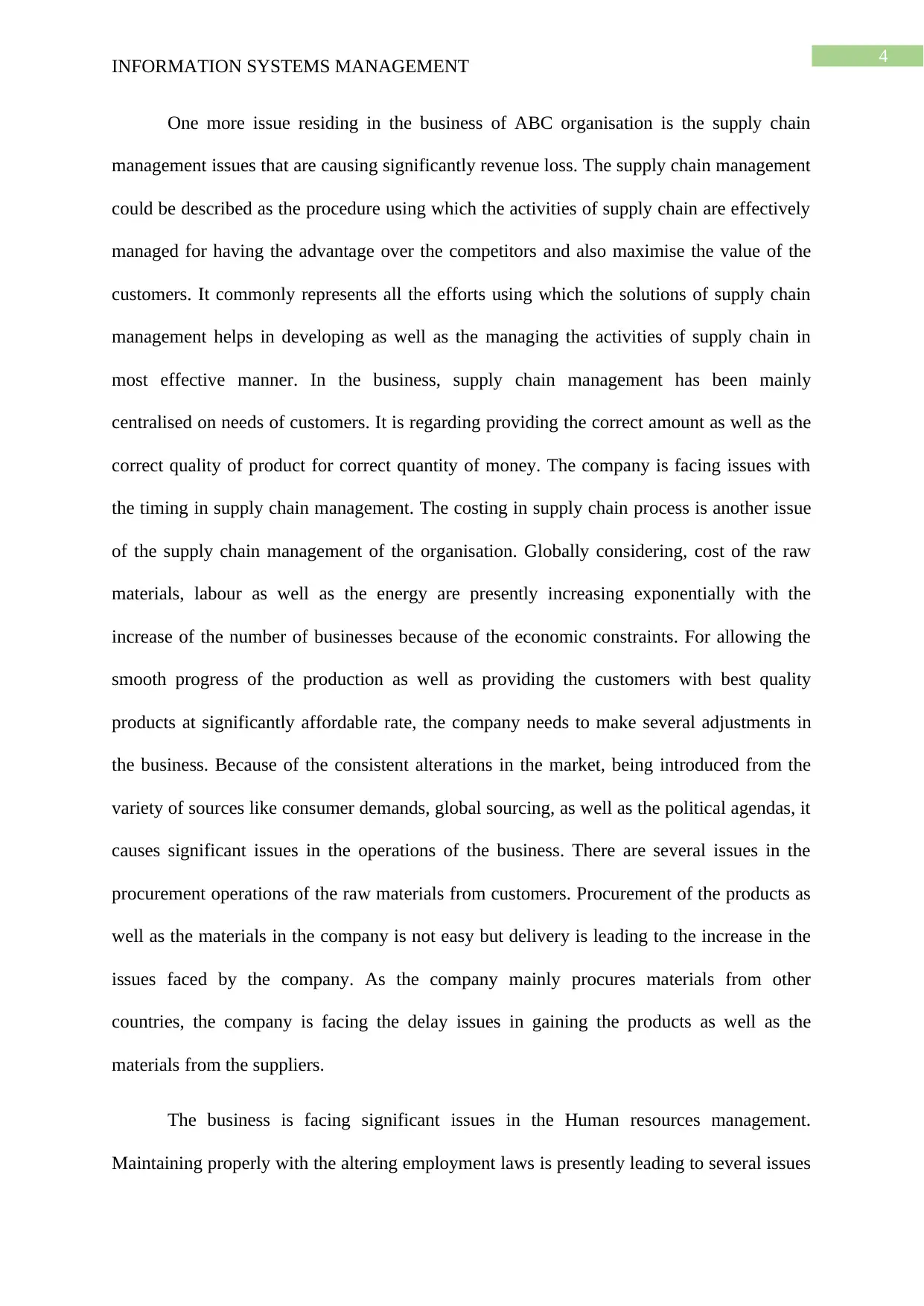
4
INFORMATION SYSTEMS MANAGEMENT
One more issue residing in the business of ABC organisation is the supply chain
management issues that are causing significantly revenue loss. The supply chain management
could be described as the procedure using which the activities of supply chain are effectively
managed for having the advantage over the competitors and also maximise the value of the
customers. It commonly represents all the efforts using which the solutions of supply chain
management helps in developing as well as the managing the activities of supply chain in
most effective manner. In the business, supply chain management has been mainly
centralised on needs of customers. It is regarding providing the correct amount as well as the
correct quality of product for correct quantity of money. The company is facing issues with
the timing in supply chain management. The costing in supply chain process is another issue
of the supply chain management of the organisation. Globally considering, cost of the raw
materials, labour as well as the energy are presently increasing exponentially with the
increase of the number of businesses because of the economic constraints. For allowing the
smooth progress of the production as well as providing the customers with best quality
products at significantly affordable rate, the company needs to make several adjustments in
the business. Because of the consistent alterations in the market, being introduced from the
variety of sources like consumer demands, global sourcing, as well as the political agendas, it
causes significant issues in the operations of the business. There are several issues in the
procurement operations of the raw materials from customers. Procurement of the products as
well as the materials in the company is not easy but delivery is leading to the increase in the
issues faced by the company. As the company mainly procures materials from other
countries, the company is facing the delay issues in gaining the products as well as the
materials from the suppliers.
The business is facing significant issues in the Human resources management.
Maintaining properly with the altering employment laws is presently leading to several issues
INFORMATION SYSTEMS MANAGEMENT
One more issue residing in the business of ABC organisation is the supply chain
management issues that are causing significantly revenue loss. The supply chain management
could be described as the procedure using which the activities of supply chain are effectively
managed for having the advantage over the competitors and also maximise the value of the
customers. It commonly represents all the efforts using which the solutions of supply chain
management helps in developing as well as the managing the activities of supply chain in
most effective manner. In the business, supply chain management has been mainly
centralised on needs of customers. It is regarding providing the correct amount as well as the
correct quality of product for correct quantity of money. The company is facing issues with
the timing in supply chain management. The costing in supply chain process is another issue
of the supply chain management of the organisation. Globally considering, cost of the raw
materials, labour as well as the energy are presently increasing exponentially with the
increase of the number of businesses because of the economic constraints. For allowing the
smooth progress of the production as well as providing the customers with best quality
products at significantly affordable rate, the company needs to make several adjustments in
the business. Because of the consistent alterations in the market, being introduced from the
variety of sources like consumer demands, global sourcing, as well as the political agendas, it
causes significant issues in the operations of the business. There are several issues in the
procurement operations of the raw materials from customers. Procurement of the products as
well as the materials in the company is not easy but delivery is leading to the increase in the
issues faced by the company. As the company mainly procures materials from other
countries, the company is facing the delay issues in gaining the products as well as the
materials from the suppliers.
The business is facing significant issues in the Human resources management.
Maintaining properly with the altering employment laws is presently leading to several issues
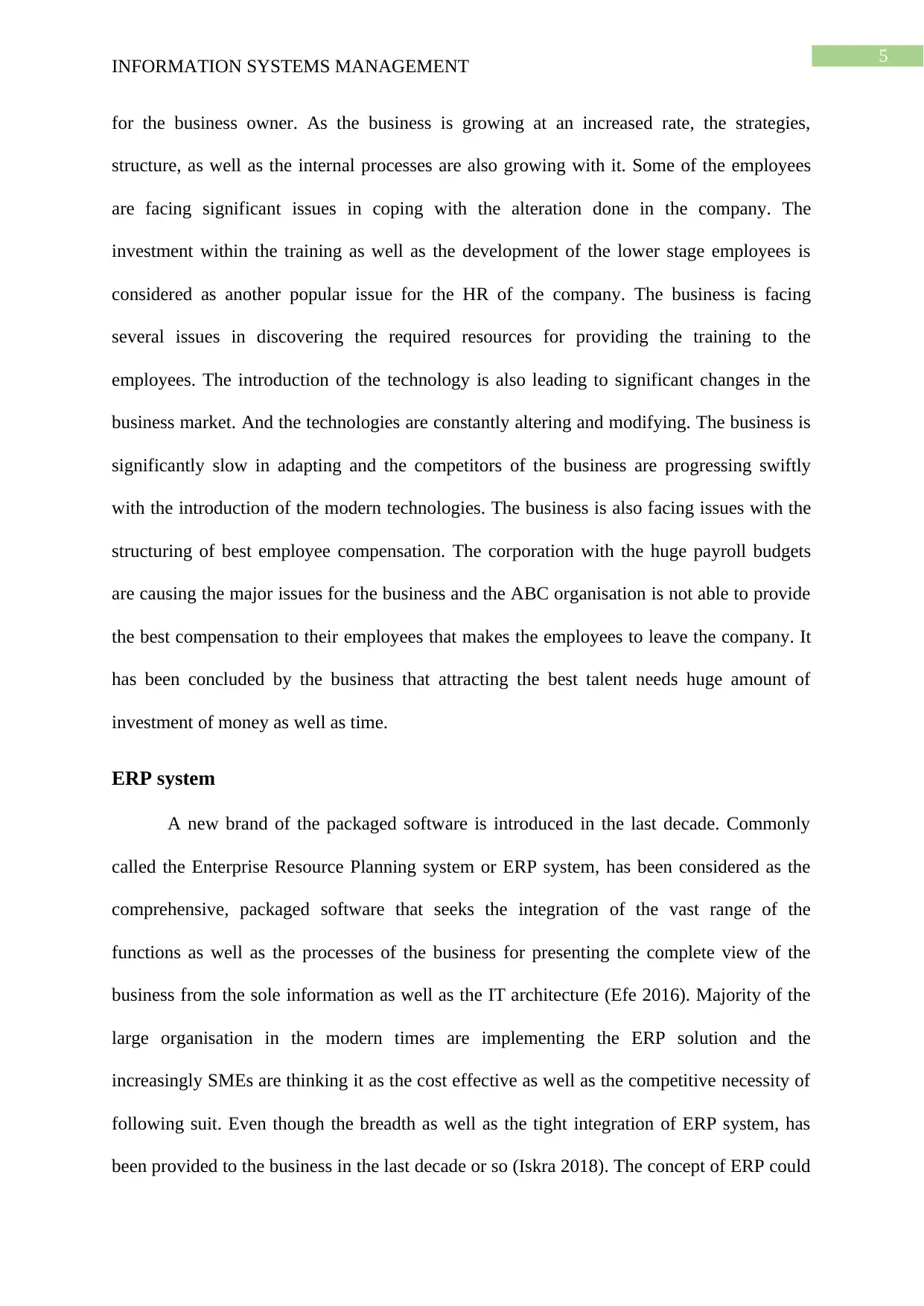
5
INFORMATION SYSTEMS MANAGEMENT
for the business owner. As the business is growing at an increased rate, the strategies,
structure, as well as the internal processes are also growing with it. Some of the employees
are facing significant issues in coping with the alteration done in the company. The
investment within the training as well as the development of the lower stage employees is
considered as another popular issue for the HR of the company. The business is facing
several issues in discovering the required resources for providing the training to the
employees. The introduction of the technology is also leading to significant changes in the
business market. And the technologies are constantly altering and modifying. The business is
significantly slow in adapting and the competitors of the business are progressing swiftly
with the introduction of the modern technologies. The business is also facing issues with the
structuring of best employee compensation. The corporation with the huge payroll budgets
are causing the major issues for the business and the ABC organisation is not able to provide
the best compensation to their employees that makes the employees to leave the company. It
has been concluded by the business that attracting the best talent needs huge amount of
investment of money as well as time.
ERP system
A new brand of the packaged software is introduced in the last decade. Commonly
called the Enterprise Resource Planning system or ERP system, has been considered as the
comprehensive, packaged software that seeks the integration of the vast range of the
functions as well as the processes of the business for presenting the complete view of the
business from the sole information as well as the IT architecture (Efe 2016). Majority of the
large organisation in the modern times are implementing the ERP solution and the
increasingly SMEs are thinking it as the cost effective as well as the competitive necessity of
following suit. Even though the breadth as well as the tight integration of ERP system, has
been provided to the business in the last decade or so (Iskra 2018). The concept of ERP could
INFORMATION SYSTEMS MANAGEMENT
for the business owner. As the business is growing at an increased rate, the strategies,
structure, as well as the internal processes are also growing with it. Some of the employees
are facing significant issues in coping with the alteration done in the company. The
investment within the training as well as the development of the lower stage employees is
considered as another popular issue for the HR of the company. The business is facing
several issues in discovering the required resources for providing the training to the
employees. The introduction of the technology is also leading to significant changes in the
business market. And the technologies are constantly altering and modifying. The business is
significantly slow in adapting and the competitors of the business are progressing swiftly
with the introduction of the modern technologies. The business is also facing issues with the
structuring of best employee compensation. The corporation with the huge payroll budgets
are causing the major issues for the business and the ABC organisation is not able to provide
the best compensation to their employees that makes the employees to leave the company. It
has been concluded by the business that attracting the best talent needs huge amount of
investment of money as well as time.
ERP system
A new brand of the packaged software is introduced in the last decade. Commonly
called the Enterprise Resource Planning system or ERP system, has been considered as the
comprehensive, packaged software that seeks the integration of the vast range of the
functions as well as the processes of the business for presenting the complete view of the
business from the sole information as well as the IT architecture (Efe 2016). Majority of the
large organisation in the modern times are implementing the ERP solution and the
increasingly SMEs are thinking it as the cost effective as well as the competitive necessity of
following suit. Even though the breadth as well as the tight integration of ERP system, has
been provided to the business in the last decade or so (Iskra 2018). The concept of ERP could
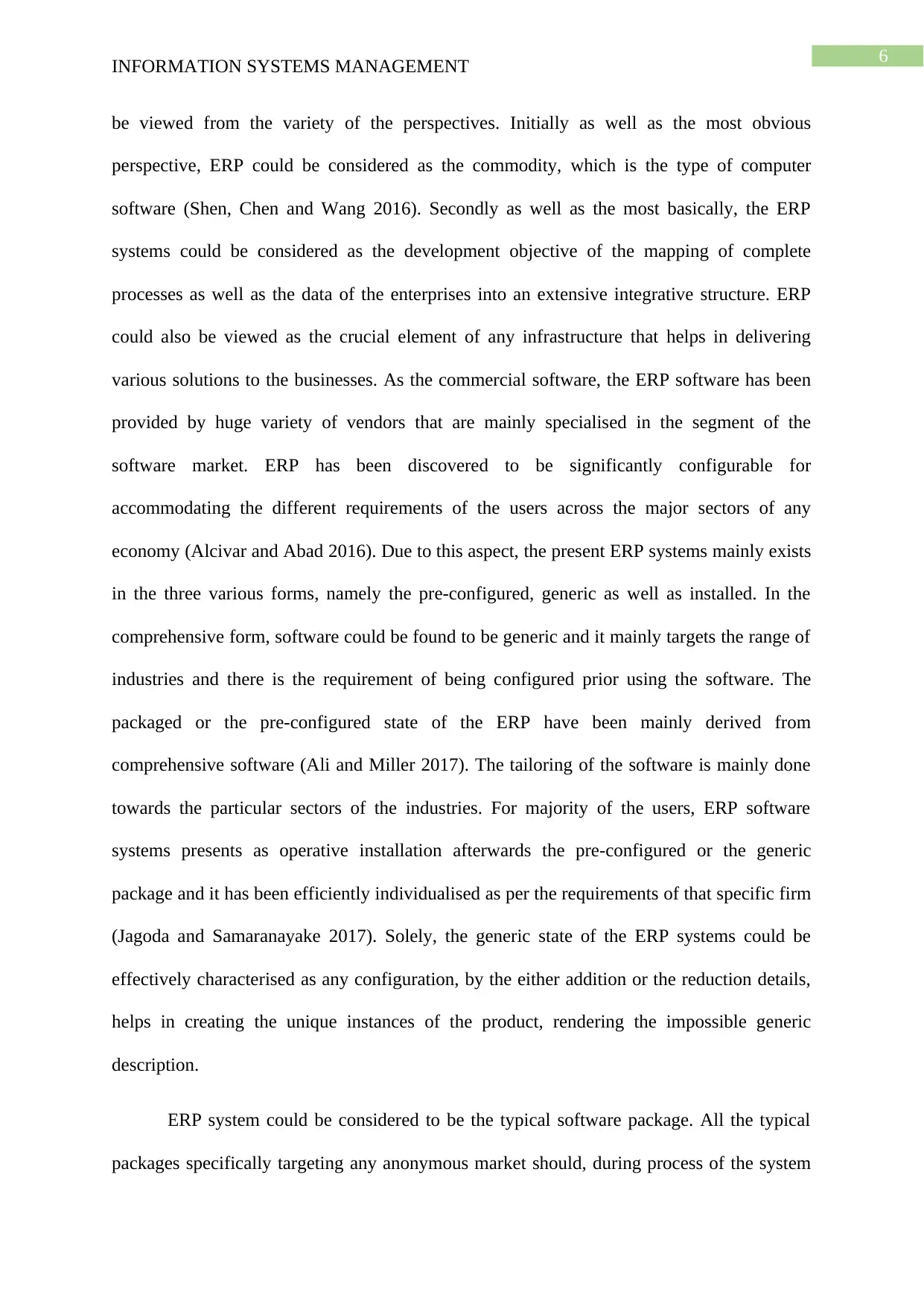
6
INFORMATION SYSTEMS MANAGEMENT
be viewed from the variety of the perspectives. Initially as well as the most obvious
perspective, ERP could be considered as the commodity, which is the type of computer
software (Shen, Chen and Wang 2016). Secondly as well as the most basically, the ERP
systems could be considered as the development objective of the mapping of complete
processes as well as the data of the enterprises into an extensive integrative structure. ERP
could also be viewed as the crucial element of any infrastructure that helps in delivering
various solutions to the businesses. As the commercial software, the ERP software has been
provided by huge variety of vendors that are mainly specialised in the segment of the
software market. ERP has been discovered to be significantly configurable for
accommodating the different requirements of the users across the major sectors of any
economy (Alcivar and Abad 2016). Due to this aspect, the present ERP systems mainly exists
in the three various forms, namely the pre-configured, generic as well as installed. In the
comprehensive form, software could be found to be generic and it mainly targets the range of
industries and there is the requirement of being configured prior using the software. The
packaged or the pre-configured state of the ERP have been mainly derived from
comprehensive software (Ali and Miller 2017). The tailoring of the software is mainly done
towards the particular sectors of the industries. For majority of the users, ERP software
systems presents as operative installation afterwards the pre-configured or the generic
package and it has been efficiently individualised as per the requirements of that specific firm
(Jagoda and Samaranayake 2017). Solely, the generic state of the ERP systems could be
effectively characterised as any configuration, by the either addition or the reduction details,
helps in creating the unique instances of the product, rendering the impossible generic
description.
ERP system could be considered to be the typical software package. All the typical
packages specifically targeting any anonymous market should, during process of the system
INFORMATION SYSTEMS MANAGEMENT
be viewed from the variety of the perspectives. Initially as well as the most obvious
perspective, ERP could be considered as the commodity, which is the type of computer
software (Shen, Chen and Wang 2016). Secondly as well as the most basically, the ERP
systems could be considered as the development objective of the mapping of complete
processes as well as the data of the enterprises into an extensive integrative structure. ERP
could also be viewed as the crucial element of any infrastructure that helps in delivering
various solutions to the businesses. As the commercial software, the ERP software has been
provided by huge variety of vendors that are mainly specialised in the segment of the
software market. ERP has been discovered to be significantly configurable for
accommodating the different requirements of the users across the major sectors of any
economy (Alcivar and Abad 2016). Due to this aspect, the present ERP systems mainly exists
in the three various forms, namely the pre-configured, generic as well as installed. In the
comprehensive form, software could be found to be generic and it mainly targets the range of
industries and there is the requirement of being configured prior using the software. The
packaged or the pre-configured state of the ERP have been mainly derived from
comprehensive software (Ali and Miller 2017). The tailoring of the software is mainly done
towards the particular sectors of the industries. For majority of the users, ERP software
systems presents as operative installation afterwards the pre-configured or the generic
package and it has been efficiently individualised as per the requirements of that specific firm
(Jagoda and Samaranayake 2017). Solely, the generic state of the ERP systems could be
effectively characterised as any configuration, by the either addition or the reduction details,
helps in creating the unique instances of the product, rendering the impossible generic
description.
ERP system could be considered to be the typical software package. All the typical
packages specifically targeting any anonymous market should, during process of the system
Paraphrase This Document
Need a fresh take? Get an instant paraphrase of this document with our AI Paraphraser
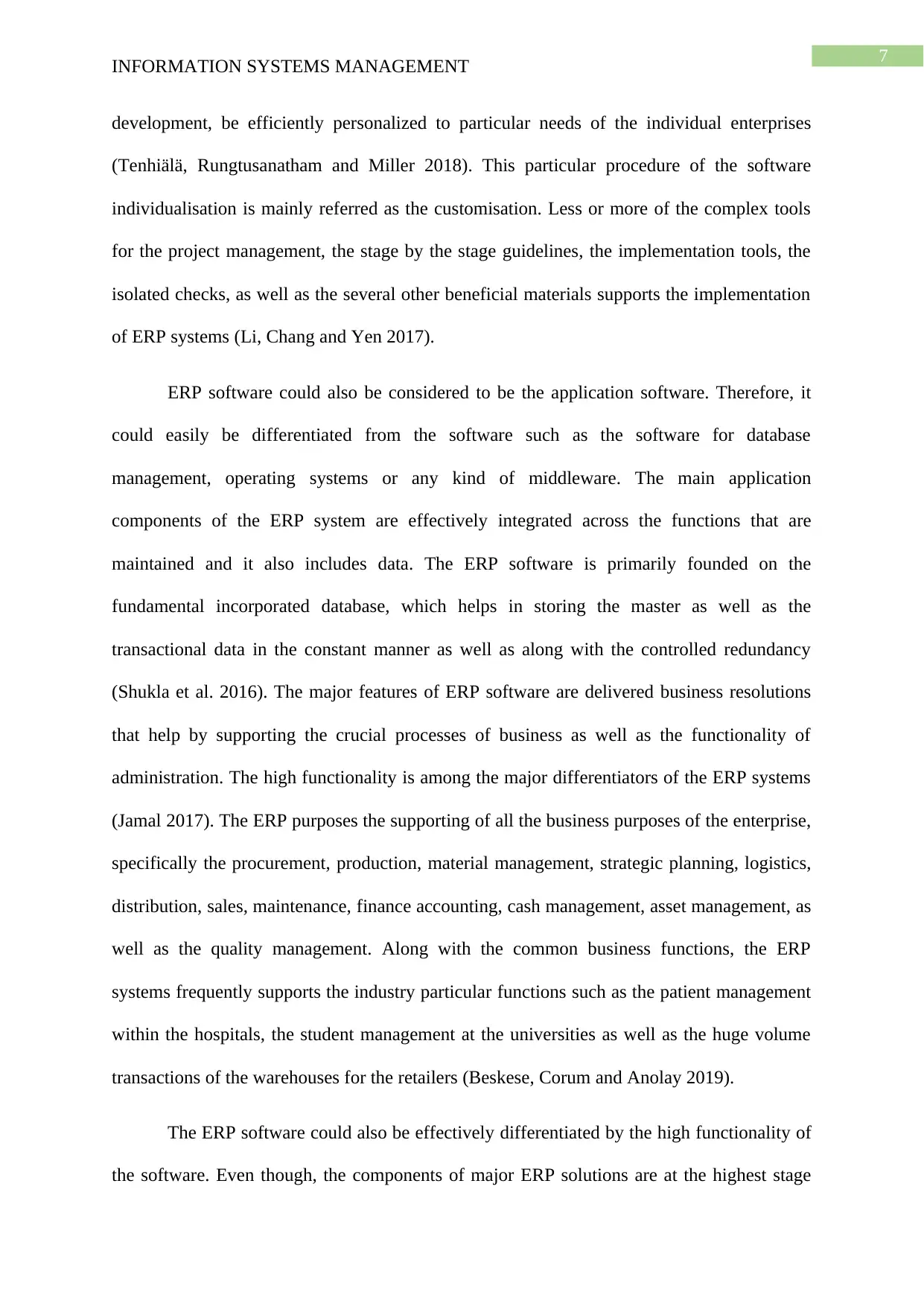
7
INFORMATION SYSTEMS MANAGEMENT
development, be efficiently personalized to particular needs of the individual enterprises
(Tenhiälä, Rungtusanatham and Miller 2018). This particular procedure of the software
individualisation is mainly referred as the customisation. Less or more of the complex tools
for the project management, the stage by the stage guidelines, the implementation tools, the
isolated checks, as well as the several other beneficial materials supports the implementation
of ERP systems (Li, Chang and Yen 2017).
ERP software could also be considered to be the application software. Therefore, it
could easily be differentiated from the software such as the software for database
management, operating systems or any kind of middleware. The main application
components of the ERP system are effectively integrated across the functions that are
maintained and it also includes data. The ERP software is primarily founded on the
fundamental incorporated database, which helps in storing the master as well as the
transactional data in the constant manner as well as along with the controlled redundancy
(Shukla et al. 2016). The major features of ERP software are delivered business resolutions
that help by supporting the crucial processes of business as well as the functionality of
administration. The high functionality is among the major differentiators of the ERP systems
(Jamal 2017). The ERP purposes the supporting of all the business purposes of the enterprise,
specifically the procurement, production, material management, strategic planning, logistics,
distribution, sales, maintenance, finance accounting, cash management, asset management, as
well as the quality management. Along with the common business functions, the ERP
systems frequently supports the industry particular functions such as the patient management
within the hospitals, the student management at the universities as well as the huge volume
transactions of the warehouses for the retailers (Beskese, Corum and Anolay 2019).
The ERP software could also be effectively differentiated by the high functionality of
the software. Even though, the components of major ERP solutions are at the highest stage
INFORMATION SYSTEMS MANAGEMENT
development, be efficiently personalized to particular needs of the individual enterprises
(Tenhiälä, Rungtusanatham and Miller 2018). This particular procedure of the software
individualisation is mainly referred as the customisation. Less or more of the complex tools
for the project management, the stage by the stage guidelines, the implementation tools, the
isolated checks, as well as the several other beneficial materials supports the implementation
of ERP systems (Li, Chang and Yen 2017).
ERP software could also be considered to be the application software. Therefore, it
could easily be differentiated from the software such as the software for database
management, operating systems or any kind of middleware. The main application
components of the ERP system are effectively integrated across the functions that are
maintained and it also includes data. The ERP software is primarily founded on the
fundamental incorporated database, which helps in storing the master as well as the
transactional data in the constant manner as well as along with the controlled redundancy
(Shukla et al. 2016). The major features of ERP software are delivered business resolutions
that help by supporting the crucial processes of business as well as the functionality of
administration. The high functionality is among the major differentiators of the ERP systems
(Jamal 2017). The ERP purposes the supporting of all the business purposes of the enterprise,
specifically the procurement, production, material management, strategic planning, logistics,
distribution, sales, maintenance, finance accounting, cash management, asset management, as
well as the quality management. Along with the common business functions, the ERP
systems frequently supports the industry particular functions such as the patient management
within the hospitals, the student management at the universities as well as the huge volume
transactions of the warehouses for the retailers (Beskese, Corum and Anolay 2019).
The ERP software could also be effectively differentiated by the high functionality of
the software. Even though, the components of major ERP solutions are at the highest stage
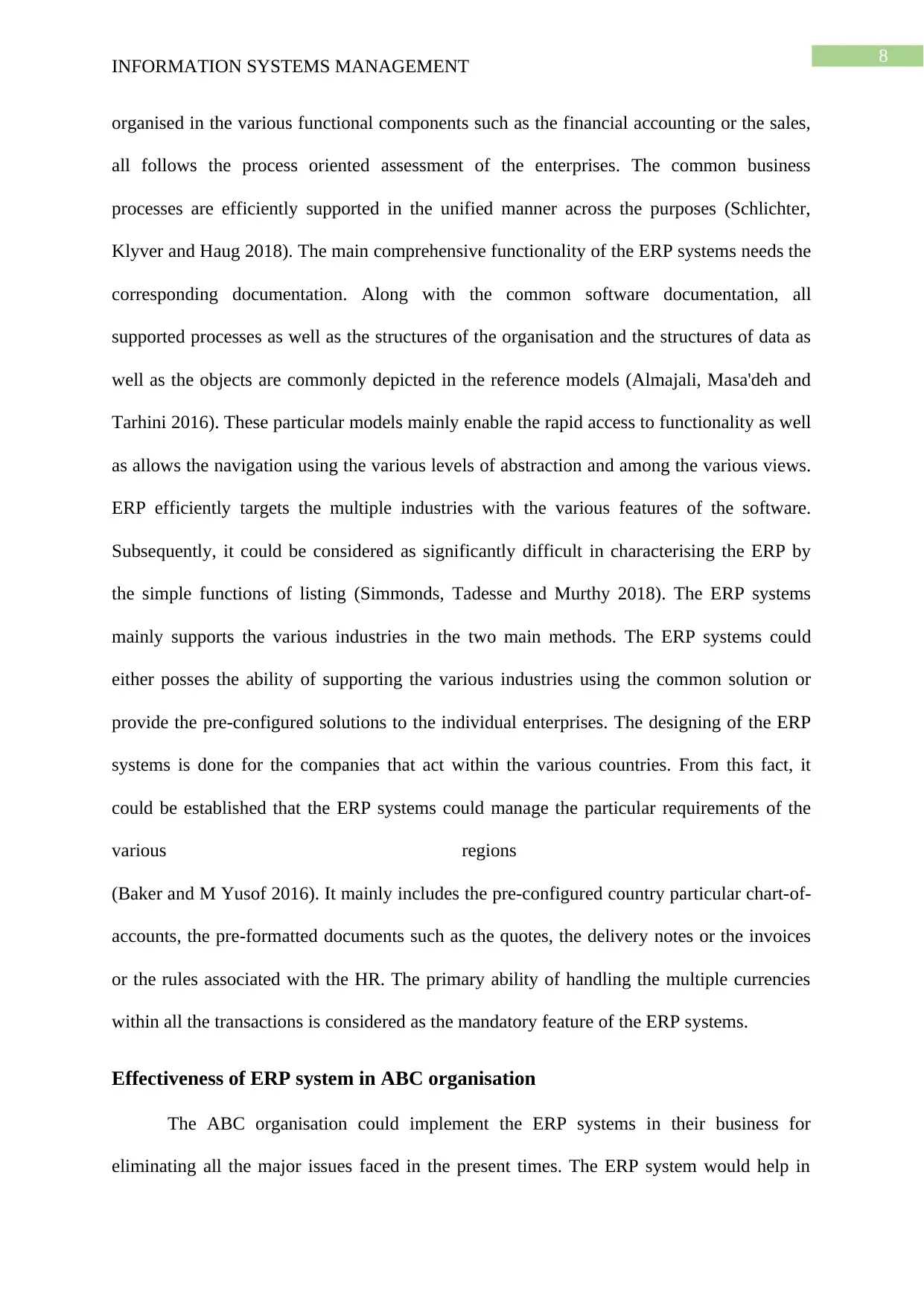
8
INFORMATION SYSTEMS MANAGEMENT
organised in the various functional components such as the financial accounting or the sales,
all follows the process oriented assessment of the enterprises. The common business
processes are efficiently supported in the unified manner across the purposes (Schlichter,
Klyver and Haug 2018). The main comprehensive functionality of the ERP systems needs the
corresponding documentation. Along with the common software documentation, all
supported processes as well as the structures of the organisation and the structures of data as
well as the objects are commonly depicted in the reference models (Almajali, Masa'deh and
Tarhini 2016). These particular models mainly enable the rapid access to functionality as well
as allows the navigation using the various levels of abstraction and among the various views.
ERP efficiently targets the multiple industries with the various features of the software.
Subsequently, it could be considered as significantly difficult in characterising the ERP by
the simple functions of listing (Simmonds, Tadesse and Murthy 2018). The ERP systems
mainly supports the various industries in the two main methods. The ERP systems could
either posses the ability of supporting the various industries using the common solution or
provide the pre-configured solutions to the individual enterprises. The designing of the ERP
systems is done for the companies that act within the various countries. From this fact, it
could be established that the ERP systems could manage the particular requirements of the
various regions
(Baker and M Yusof 2016). It mainly includes the pre-configured country particular chart-of-
accounts, the pre-formatted documents such as the quotes, the delivery notes or the invoices
or the rules associated with the HR. The primary ability of handling the multiple currencies
within all the transactions is considered as the mandatory feature of the ERP systems.
Effectiveness of ERP system in ABC organisation
The ABC organisation could implement the ERP systems in their business for
eliminating all the major issues faced in the present times. The ERP system would help in
INFORMATION SYSTEMS MANAGEMENT
organised in the various functional components such as the financial accounting or the sales,
all follows the process oriented assessment of the enterprises. The common business
processes are efficiently supported in the unified manner across the purposes (Schlichter,
Klyver and Haug 2018). The main comprehensive functionality of the ERP systems needs the
corresponding documentation. Along with the common software documentation, all
supported processes as well as the structures of the organisation and the structures of data as
well as the objects are commonly depicted in the reference models (Almajali, Masa'deh and
Tarhini 2016). These particular models mainly enable the rapid access to functionality as well
as allows the navigation using the various levels of abstraction and among the various views.
ERP efficiently targets the multiple industries with the various features of the software.
Subsequently, it could be considered as significantly difficult in characterising the ERP by
the simple functions of listing (Simmonds, Tadesse and Murthy 2018). The ERP systems
mainly supports the various industries in the two main methods. The ERP systems could
either posses the ability of supporting the various industries using the common solution or
provide the pre-configured solutions to the individual enterprises. The designing of the ERP
systems is done for the companies that act within the various countries. From this fact, it
could be established that the ERP systems could manage the particular requirements of the
various regions
(Baker and M Yusof 2016). It mainly includes the pre-configured country particular chart-of-
accounts, the pre-formatted documents such as the quotes, the delivery notes or the invoices
or the rules associated with the HR. The primary ability of handling the multiple currencies
within all the transactions is considered as the mandatory feature of the ERP systems.
Effectiveness of ERP system in ABC organisation
The ABC organisation could implement the ERP systems in their business for
eliminating all the major issues faced in the present times. The ERP system would help in
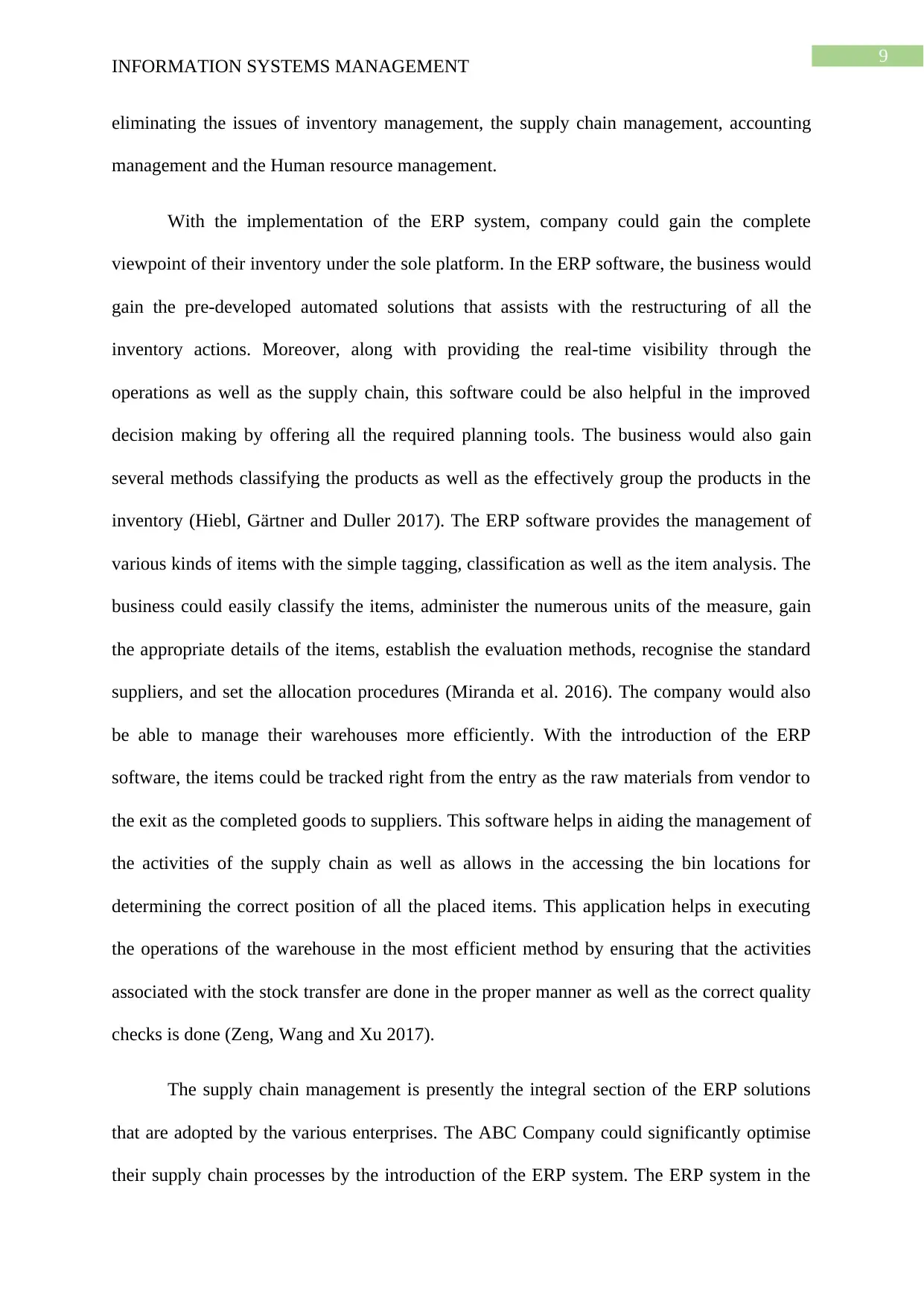
9
INFORMATION SYSTEMS MANAGEMENT
eliminating the issues of inventory management, the supply chain management, accounting
management and the Human resource management.
With the implementation of the ERP system, company could gain the complete
viewpoint of their inventory under the sole platform. In the ERP software, the business would
gain the pre-developed automated solutions that assists with the restructuring of all the
inventory actions. Moreover, along with providing the real-time visibility through the
operations as well as the supply chain, this software could be also helpful in the improved
decision making by offering all the required planning tools. The business would also gain
several methods classifying the products as well as the effectively group the products in the
inventory (Hiebl, Gärtner and Duller 2017). The ERP software provides the management of
various kinds of items with the simple tagging, classification as well as the item analysis. The
business could easily classify the items, administer the numerous units of the measure, gain
the appropriate details of the items, establish the evaluation methods, recognise the standard
suppliers, and set the allocation procedures (Miranda et al. 2016). The company would also
be able to manage their warehouses more efficiently. With the introduction of the ERP
software, the items could be tracked right from the entry as the raw materials from vendor to
the exit as the completed goods to suppliers. This software helps in aiding the management of
the activities of the supply chain as well as allows in the accessing the bin locations for
determining the correct position of all the placed items. This application helps in executing
the operations of the warehouse in the most efficient method by ensuring that the activities
associated with the stock transfer are done in the proper manner as well as the correct quality
checks is done (Zeng, Wang and Xu 2017).
The supply chain management is presently the integral section of the ERP solutions
that are adopted by the various enterprises. The ABC Company could significantly optimise
their supply chain processes by the introduction of the ERP system. The ERP system in the
INFORMATION SYSTEMS MANAGEMENT
eliminating the issues of inventory management, the supply chain management, accounting
management and the Human resource management.
With the implementation of the ERP system, company could gain the complete
viewpoint of their inventory under the sole platform. In the ERP software, the business would
gain the pre-developed automated solutions that assists with the restructuring of all the
inventory actions. Moreover, along with providing the real-time visibility through the
operations as well as the supply chain, this software could be also helpful in the improved
decision making by offering all the required planning tools. The business would also gain
several methods classifying the products as well as the effectively group the products in the
inventory (Hiebl, Gärtner and Duller 2017). The ERP software provides the management of
various kinds of items with the simple tagging, classification as well as the item analysis. The
business could easily classify the items, administer the numerous units of the measure, gain
the appropriate details of the items, establish the evaluation methods, recognise the standard
suppliers, and set the allocation procedures (Miranda et al. 2016). The company would also
be able to manage their warehouses more efficiently. With the introduction of the ERP
software, the items could be tracked right from the entry as the raw materials from vendor to
the exit as the completed goods to suppliers. This software helps in aiding the management of
the activities of the supply chain as well as allows in the accessing the bin locations for
determining the correct position of all the placed items. This application helps in executing
the operations of the warehouse in the most efficient method by ensuring that the activities
associated with the stock transfer are done in the proper manner as well as the correct quality
checks is done (Zeng, Wang and Xu 2017).
The supply chain management is presently the integral section of the ERP solutions
that are adopted by the various enterprises. The ABC Company could significantly optimise
their supply chain processes by the introduction of the ERP system. The ERP system in the
Secure Best Marks with AI Grader
Need help grading? Try our AI Grader for instant feedback on your assignments.
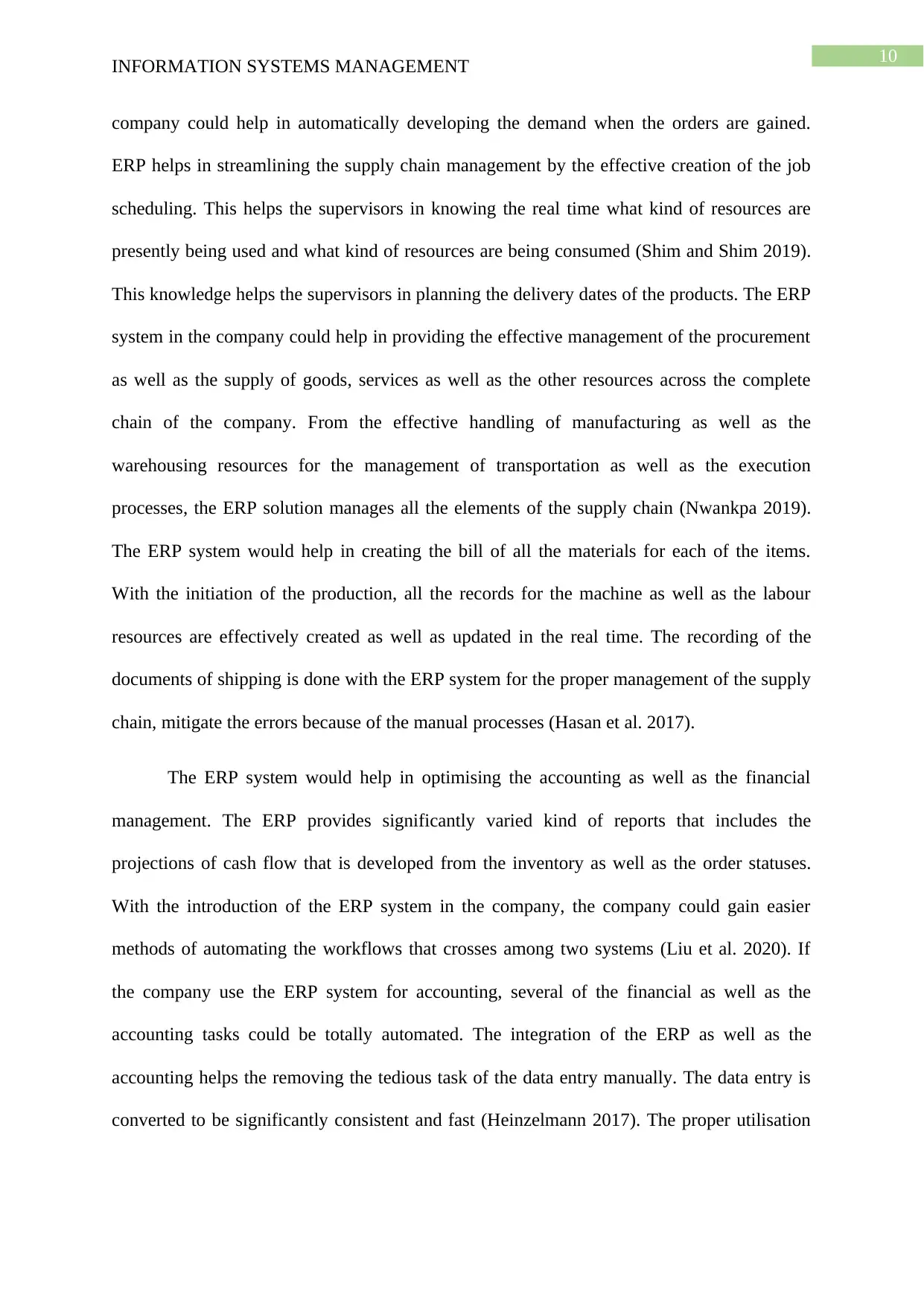
10
INFORMATION SYSTEMS MANAGEMENT
company could help in automatically developing the demand when the orders are gained.
ERP helps in streamlining the supply chain management by the effective creation of the job
scheduling. This helps the supervisors in knowing the real time what kind of resources are
presently being used and what kind of resources are being consumed (Shim and Shim 2019).
This knowledge helps the supervisors in planning the delivery dates of the products. The ERP
system in the company could help in providing the effective management of the procurement
as well as the supply of goods, services as well as the other resources across the complete
chain of the company. From the effective handling of manufacturing as well as the
warehousing resources for the management of transportation as well as the execution
processes, the ERP solution manages all the elements of the supply chain (Nwankpa 2019).
The ERP system would help in creating the bill of all the materials for each of the items.
With the initiation of the production, all the records for the machine as well as the labour
resources are effectively created as well as updated in the real time. The recording of the
documents of shipping is done with the ERP system for the proper management of the supply
chain, mitigate the errors because of the manual processes (Hasan et al. 2017).
The ERP system would help in optimising the accounting as well as the financial
management. The ERP provides significantly varied kind of reports that includes the
projections of cash flow that is developed from the inventory as well as the order statuses.
With the introduction of the ERP system in the company, the company could gain easier
methods of automating the workflows that crosses among two systems (Liu et al. 2020). If
the company use the ERP system for accounting, several of the financial as well as the
accounting tasks could be totally automated. The integration of the ERP as well as the
accounting helps the removing the tedious task of the data entry manually. The data entry is
converted to be significantly consistent and fast (Heinzelmann 2017). The proper utilisation
INFORMATION SYSTEMS MANAGEMENT
company could help in automatically developing the demand when the orders are gained.
ERP helps in streamlining the supply chain management by the effective creation of the job
scheduling. This helps the supervisors in knowing the real time what kind of resources are
presently being used and what kind of resources are being consumed (Shim and Shim 2019).
This knowledge helps the supervisors in planning the delivery dates of the products. The ERP
system in the company could help in providing the effective management of the procurement
as well as the supply of goods, services as well as the other resources across the complete
chain of the company. From the effective handling of manufacturing as well as the
warehousing resources for the management of transportation as well as the execution
processes, the ERP solution manages all the elements of the supply chain (Nwankpa 2019).
The ERP system would help in creating the bill of all the materials for each of the items.
With the initiation of the production, all the records for the machine as well as the labour
resources are effectively created as well as updated in the real time. The recording of the
documents of shipping is done with the ERP system for the proper management of the supply
chain, mitigate the errors because of the manual processes (Hasan et al. 2017).
The ERP system would help in optimising the accounting as well as the financial
management. The ERP provides significantly varied kind of reports that includes the
projections of cash flow that is developed from the inventory as well as the order statuses.
With the introduction of the ERP system in the company, the company could gain easier
methods of automating the workflows that crosses among two systems (Liu et al. 2020). If
the company use the ERP system for accounting, several of the financial as well as the
accounting tasks could be totally automated. The integration of the ERP as well as the
accounting helps the removing the tedious task of the data entry manually. The data entry is
converted to be significantly consistent and fast (Heinzelmann 2017). The proper utilisation
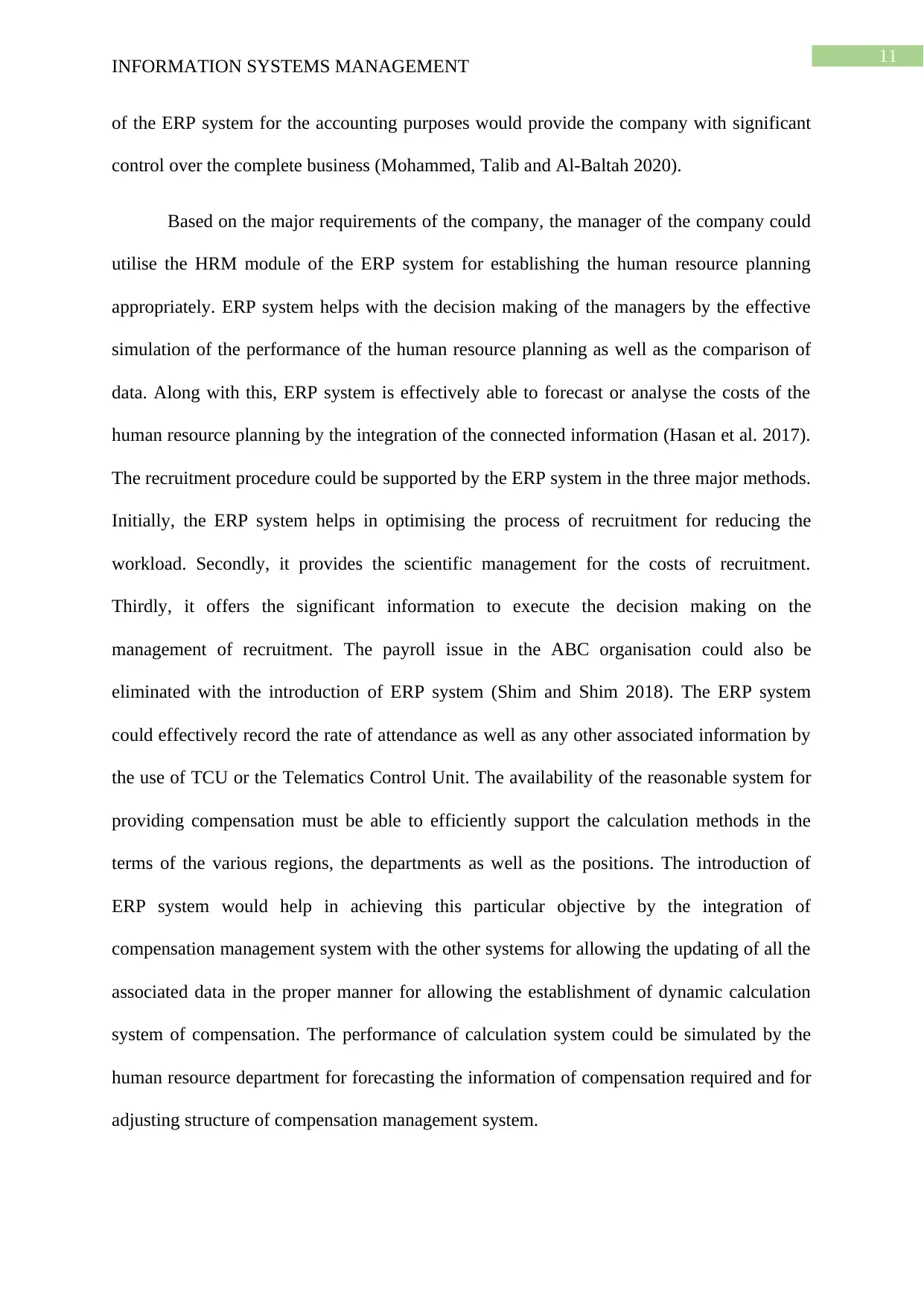
11
INFORMATION SYSTEMS MANAGEMENT
of the ERP system for the accounting purposes would provide the company with significant
control over the complete business (Mohammed, Talib and Al-Baltah 2020).
Based on the major requirements of the company, the manager of the company could
utilise the HRM module of the ERP system for establishing the human resource planning
appropriately. ERP system helps with the decision making of the managers by the effective
simulation of the performance of the human resource planning as well as the comparison of
data. Along with this, ERP system is effectively able to forecast or analyse the costs of the
human resource planning by the integration of the connected information (Hasan et al. 2017).
The recruitment procedure could be supported by the ERP system in the three major methods.
Initially, the ERP system helps in optimising the process of recruitment for reducing the
workload. Secondly, it provides the scientific management for the costs of recruitment.
Thirdly, it offers the significant information to execute the decision making on the
management of recruitment. The payroll issue in the ABC organisation could also be
eliminated with the introduction of ERP system (Shim and Shim 2018). The ERP system
could effectively record the rate of attendance as well as any other associated information by
the use of TCU or the Telematics Control Unit. The availability of the reasonable system for
providing compensation must be able to efficiently support the calculation methods in the
terms of the various regions, the departments as well as the positions. The introduction of
ERP system would help in achieving this particular objective by the integration of
compensation management system with the other systems for allowing the updating of all the
associated data in the proper manner for allowing the establishment of dynamic calculation
system of compensation. The performance of calculation system could be simulated by the
human resource department for forecasting the information of compensation required and for
adjusting structure of compensation management system.
INFORMATION SYSTEMS MANAGEMENT
of the ERP system for the accounting purposes would provide the company with significant
control over the complete business (Mohammed, Talib and Al-Baltah 2020).
Based on the major requirements of the company, the manager of the company could
utilise the HRM module of the ERP system for establishing the human resource planning
appropriately. ERP system helps with the decision making of the managers by the effective
simulation of the performance of the human resource planning as well as the comparison of
data. Along with this, ERP system is effectively able to forecast or analyse the costs of the
human resource planning by the integration of the connected information (Hasan et al. 2017).
The recruitment procedure could be supported by the ERP system in the three major methods.
Initially, the ERP system helps in optimising the process of recruitment for reducing the
workload. Secondly, it provides the scientific management for the costs of recruitment.
Thirdly, it offers the significant information to execute the decision making on the
management of recruitment. The payroll issue in the ABC organisation could also be
eliminated with the introduction of ERP system (Shim and Shim 2018). The ERP system
could effectively record the rate of attendance as well as any other associated information by
the use of TCU or the Telematics Control Unit. The availability of the reasonable system for
providing compensation must be able to efficiently support the calculation methods in the
terms of the various regions, the departments as well as the positions. The introduction of
ERP system would help in achieving this particular objective by the integration of
compensation management system with the other systems for allowing the updating of all the
associated data in the proper manner for allowing the establishment of dynamic calculation
system of compensation. The performance of calculation system could be simulated by the
human resource department for forecasting the information of compensation required and for
adjusting structure of compensation management system.
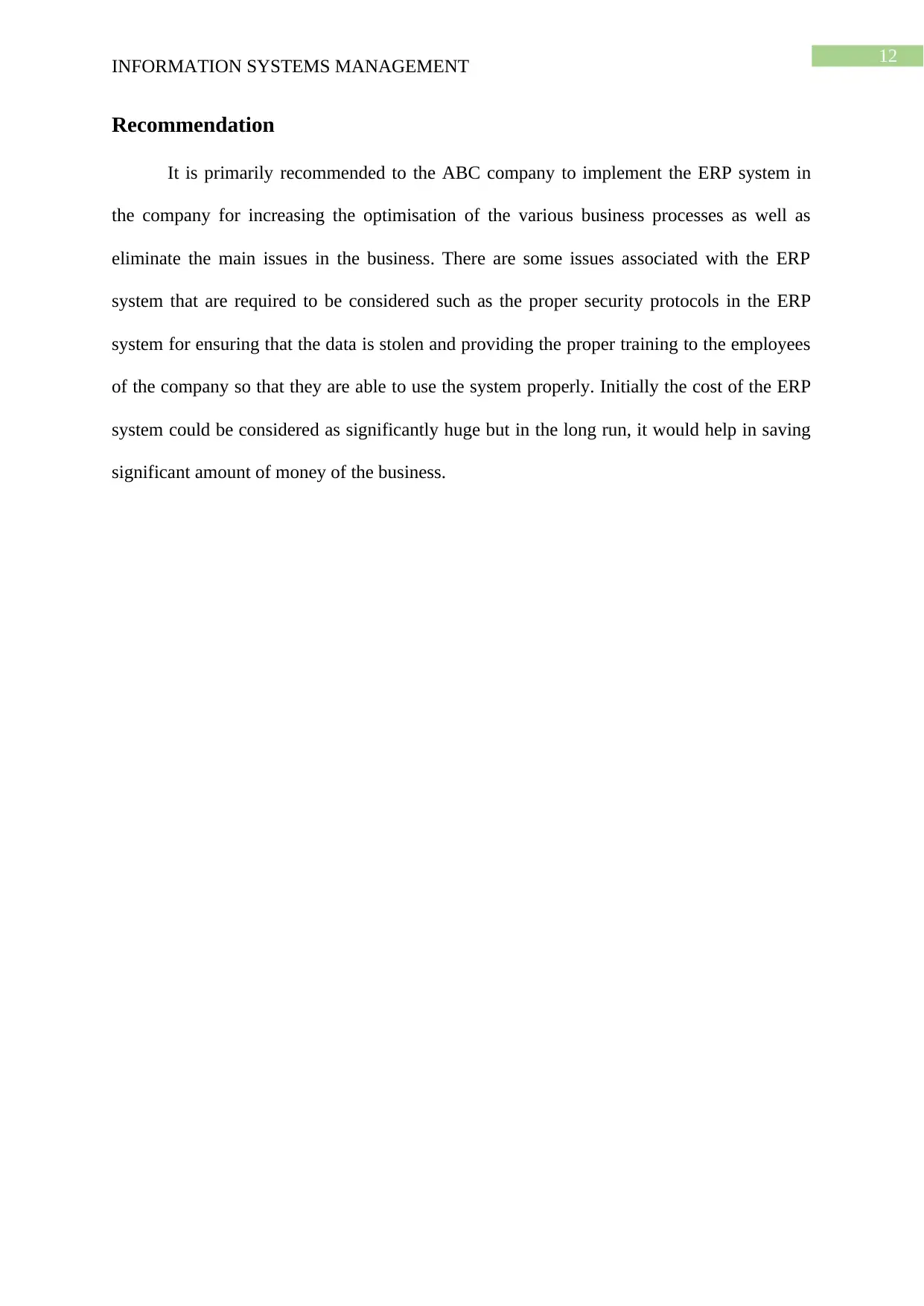
12
INFORMATION SYSTEMS MANAGEMENT
Recommendation
It is primarily recommended to the ABC company to implement the ERP system in
the company for increasing the optimisation of the various business processes as well as
eliminate the main issues in the business. There are some issues associated with the ERP
system that are required to be considered such as the proper security protocols in the ERP
system for ensuring that the data is stolen and providing the proper training to the employees
of the company so that they are able to use the system properly. Initially the cost of the ERP
system could be considered as significantly huge but in the long run, it would help in saving
significant amount of money of the business.
INFORMATION SYSTEMS MANAGEMENT
Recommendation
It is primarily recommended to the ABC company to implement the ERP system in
the company for increasing the optimisation of the various business processes as well as
eliminate the main issues in the business. There are some issues associated with the ERP
system that are required to be considered such as the proper security protocols in the ERP
system for ensuring that the data is stolen and providing the proper training to the employees
of the company so that they are able to use the system properly. Initially the cost of the ERP
system could be considered as significantly huge but in the long run, it would help in saving
significant amount of money of the business.
Paraphrase This Document
Need a fresh take? Get an instant paraphrase of this document with our AI Paraphraser
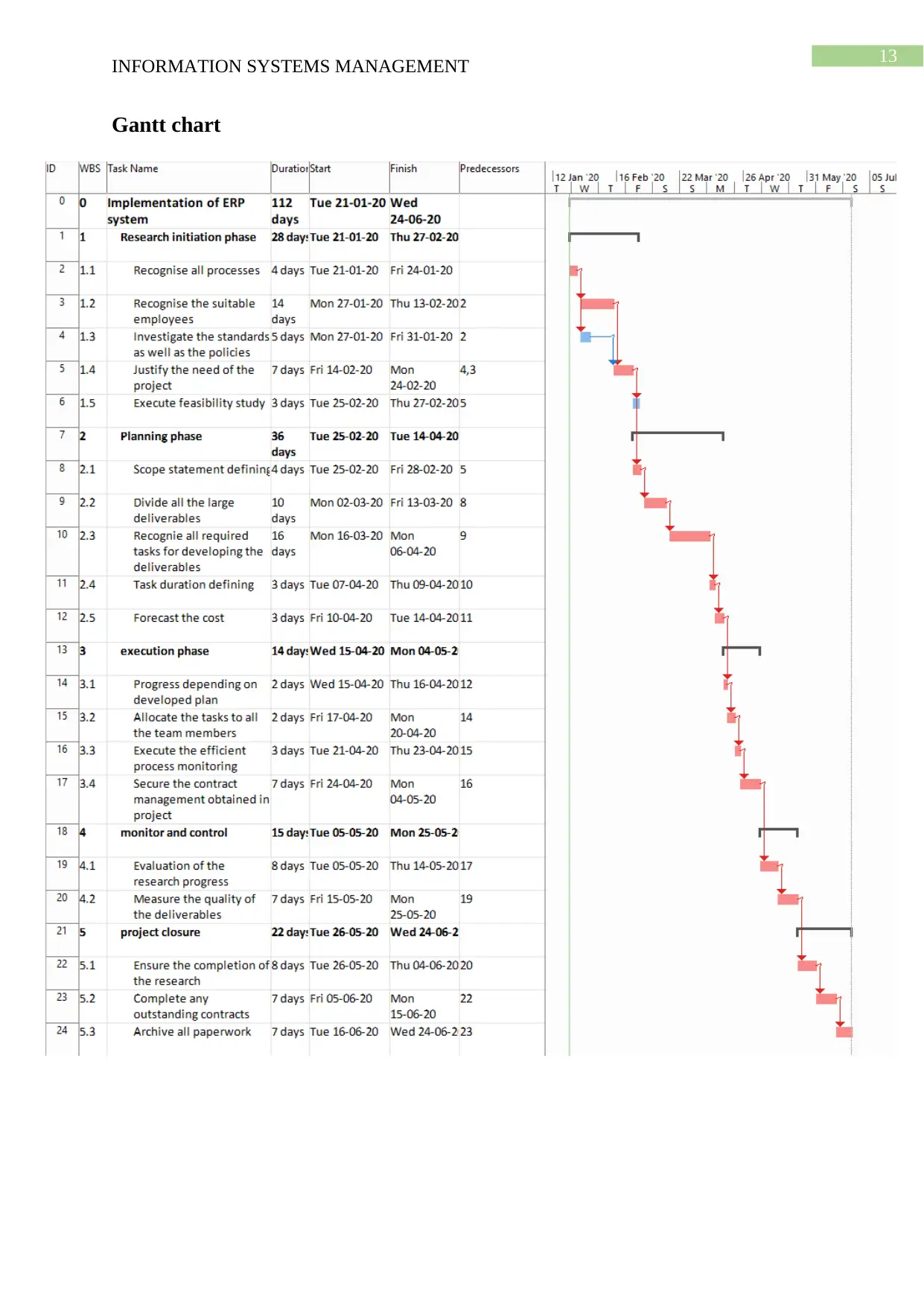
13
INFORMATION SYSTEMS MANAGEMENT
Gantt chart
INFORMATION SYSTEMS MANAGEMENT
Gantt chart
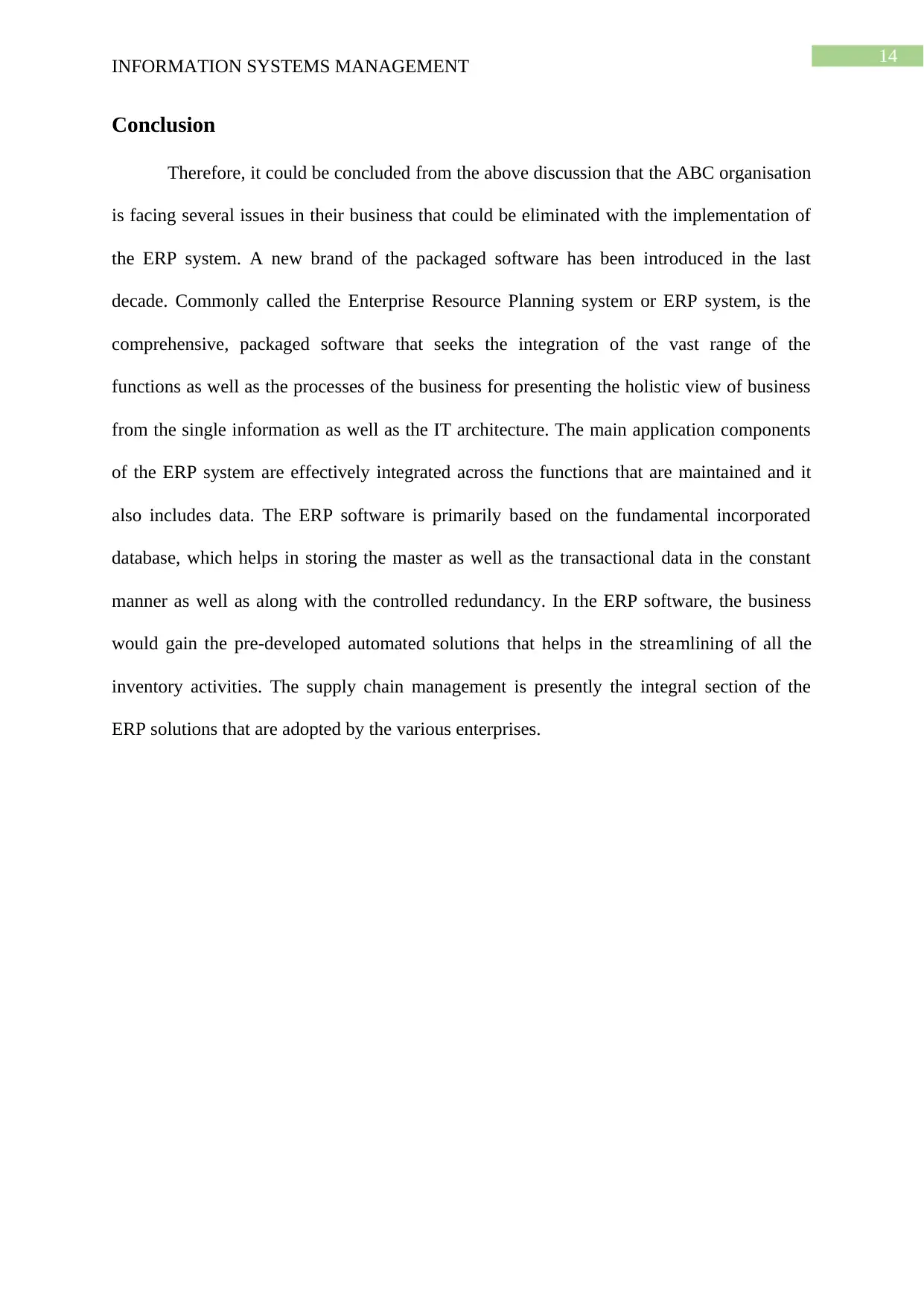
14
INFORMATION SYSTEMS MANAGEMENT
Conclusion
Therefore, it could be concluded from the above discussion that the ABC organisation
is facing several issues in their business that could be eliminated with the implementation of
the ERP system. A new brand of the packaged software has been introduced in the last
decade. Commonly called the Enterprise Resource Planning system or ERP system, is the
comprehensive, packaged software that seeks the integration of the vast range of the
functions as well as the processes of the business for presenting the holistic view of business
from the single information as well as the IT architecture. The main application components
of the ERP system are effectively integrated across the functions that are maintained and it
also includes data. The ERP software is primarily based on the fundamental incorporated
database, which helps in storing the master as well as the transactional data in the constant
manner as well as along with the controlled redundancy. In the ERP software, the business
would gain the pre-developed automated solutions that helps in the streamlining of all the
inventory activities. The supply chain management is presently the integral section of the
ERP solutions that are adopted by the various enterprises.
INFORMATION SYSTEMS MANAGEMENT
Conclusion
Therefore, it could be concluded from the above discussion that the ABC organisation
is facing several issues in their business that could be eliminated with the implementation of
the ERP system. A new brand of the packaged software has been introduced in the last
decade. Commonly called the Enterprise Resource Planning system or ERP system, is the
comprehensive, packaged software that seeks the integration of the vast range of the
functions as well as the processes of the business for presenting the holistic view of business
from the single information as well as the IT architecture. The main application components
of the ERP system are effectively integrated across the functions that are maintained and it
also includes data. The ERP software is primarily based on the fundamental incorporated
database, which helps in storing the master as well as the transactional data in the constant
manner as well as along with the controlled redundancy. In the ERP software, the business
would gain the pre-developed automated solutions that helps in the streamlining of all the
inventory activities. The supply chain management is presently the integral section of the
ERP solutions that are adopted by the various enterprises.
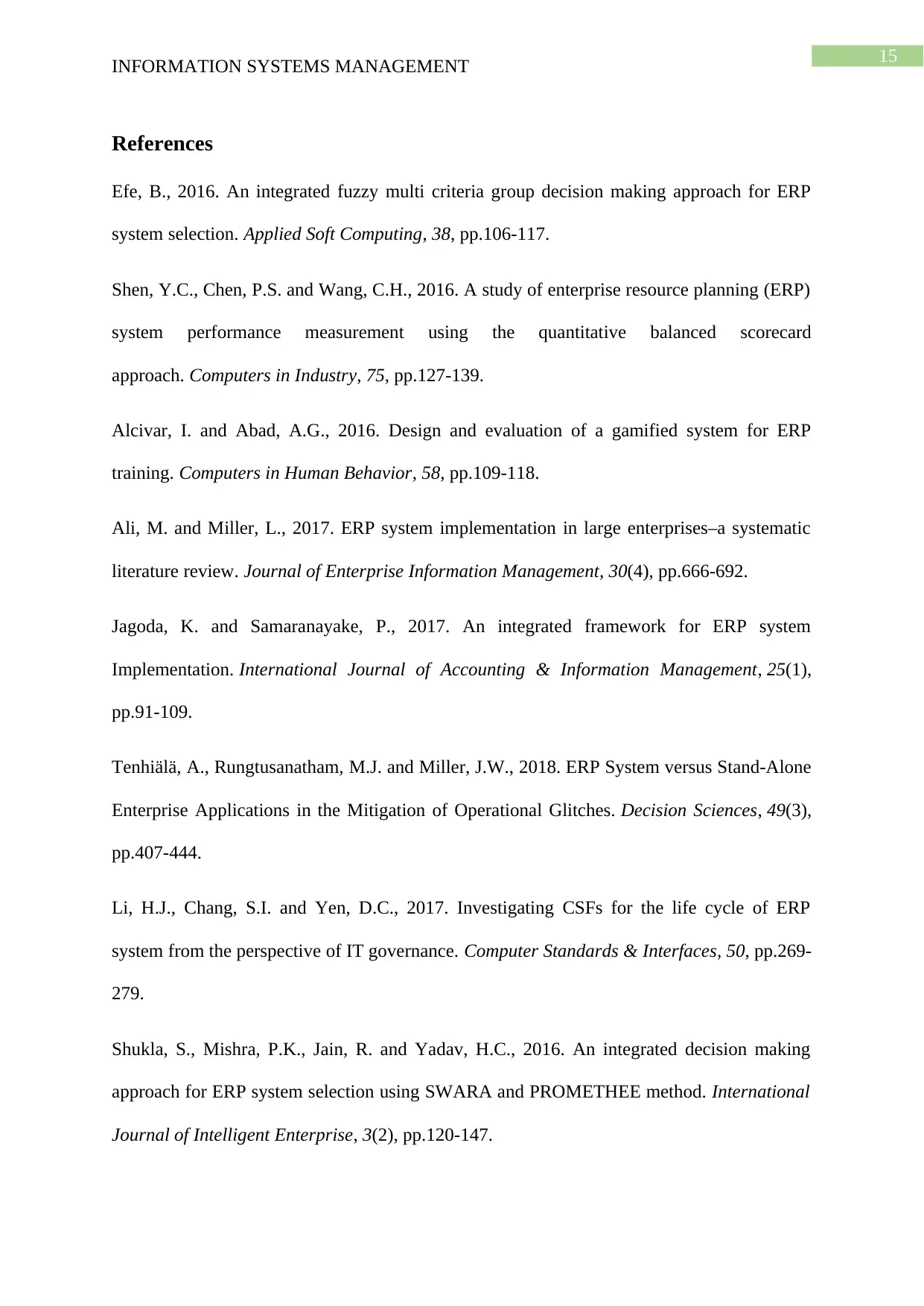
15
INFORMATION SYSTEMS MANAGEMENT
References
Efe, B., 2016. An integrated fuzzy multi criteria group decision making approach for ERP
system selection. Applied Soft Computing, 38, pp.106-117.
Shen, Y.C., Chen, P.S. and Wang, C.H., 2016. A study of enterprise resource planning (ERP)
system performance measurement using the quantitative balanced scorecard
approach. Computers in Industry, 75, pp.127-139.
Alcivar, I. and Abad, A.G., 2016. Design and evaluation of a gamified system for ERP
training. Computers in Human Behavior, 58, pp.109-118.
Ali, M. and Miller, L., 2017. ERP system implementation in large enterprises–a systematic
literature review. Journal of Enterprise Information Management, 30(4), pp.666-692.
Jagoda, K. and Samaranayake, P., 2017. An integrated framework for ERP system
Implementation. International Journal of Accounting & Information Management, 25(1),
pp.91-109.
Tenhiälä, A., Rungtusanatham, M.J. and Miller, J.W., 2018. ERP System versus Stand‐Alone
Enterprise Applications in the Mitigation of Operational Glitches. Decision Sciences, 49(3),
pp.407-444.
Li, H.J., Chang, S.I. and Yen, D.C., 2017. Investigating CSFs for the life cycle of ERP
system from the perspective of IT governance. Computer Standards & Interfaces, 50, pp.269-
279.
Shukla, S., Mishra, P.K., Jain, R. and Yadav, H.C., 2016. An integrated decision making
approach for ERP system selection using SWARA and PROMETHEE method. International
Journal of Intelligent Enterprise, 3(2), pp.120-147.
INFORMATION SYSTEMS MANAGEMENT
References
Efe, B., 2016. An integrated fuzzy multi criteria group decision making approach for ERP
system selection. Applied Soft Computing, 38, pp.106-117.
Shen, Y.C., Chen, P.S. and Wang, C.H., 2016. A study of enterprise resource planning (ERP)
system performance measurement using the quantitative balanced scorecard
approach. Computers in Industry, 75, pp.127-139.
Alcivar, I. and Abad, A.G., 2016. Design and evaluation of a gamified system for ERP
training. Computers in Human Behavior, 58, pp.109-118.
Ali, M. and Miller, L., 2017. ERP system implementation in large enterprises–a systematic
literature review. Journal of Enterprise Information Management, 30(4), pp.666-692.
Jagoda, K. and Samaranayake, P., 2017. An integrated framework for ERP system
Implementation. International Journal of Accounting & Information Management, 25(1),
pp.91-109.
Tenhiälä, A., Rungtusanatham, M.J. and Miller, J.W., 2018. ERP System versus Stand‐Alone
Enterprise Applications in the Mitigation of Operational Glitches. Decision Sciences, 49(3),
pp.407-444.
Li, H.J., Chang, S.I. and Yen, D.C., 2017. Investigating CSFs for the life cycle of ERP
system from the perspective of IT governance. Computer Standards & Interfaces, 50, pp.269-
279.
Shukla, S., Mishra, P.K., Jain, R. and Yadav, H.C., 2016. An integrated decision making
approach for ERP system selection using SWARA and PROMETHEE method. International
Journal of Intelligent Enterprise, 3(2), pp.120-147.
Secure Best Marks with AI Grader
Need help grading? Try our AI Grader for instant feedback on your assignments.
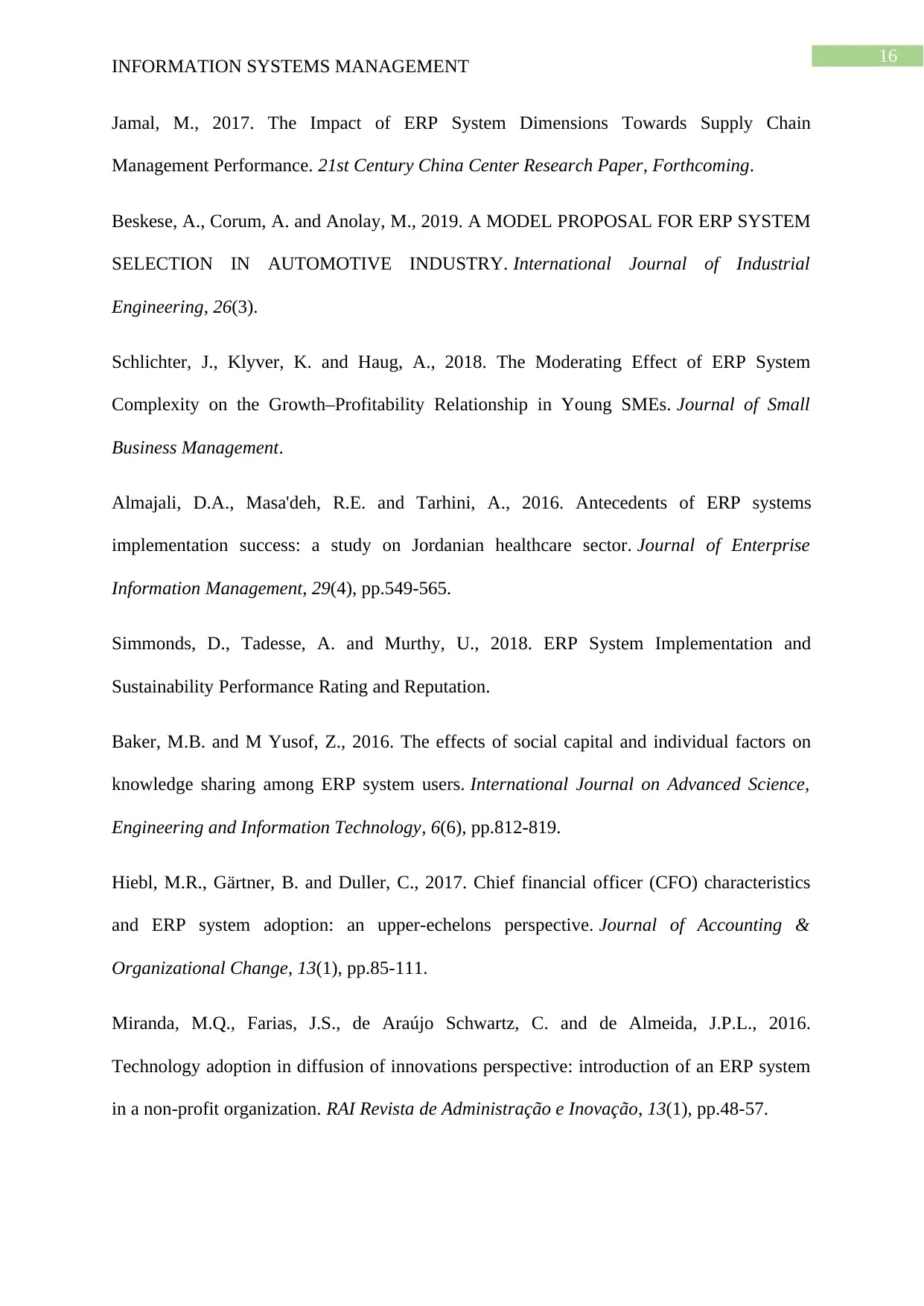
16
INFORMATION SYSTEMS MANAGEMENT
Jamal, M., 2017. The Impact of ERP System Dimensions Towards Supply Chain
Management Performance. 21st Century China Center Research Paper, Forthcoming.
Beskese, A., Corum, A. and Anolay, M., 2019. A MODEL PROPOSAL FOR ERP SYSTEM
SELECTION IN AUTOMOTIVE INDUSTRY. International Journal of Industrial
Engineering, 26(3).
Schlichter, J., Klyver, K. and Haug, A., 2018. The Moderating Effect of ERP System
Complexity on the Growth–Profitability Relationship in Young SMEs. Journal of Small
Business Management.
Almajali, D.A., Masa'deh, R.E. and Tarhini, A., 2016. Antecedents of ERP systems
implementation success: a study on Jordanian healthcare sector. Journal of Enterprise
Information Management, 29(4), pp.549-565.
Simmonds, D., Tadesse, A. and Murthy, U., 2018. ERP System Implementation and
Sustainability Performance Rating and Reputation.
Baker, M.B. and M Yusof, Z., 2016. The effects of social capital and individual factors on
knowledge sharing among ERP system users. International Journal on Advanced Science,
Engineering and Information Technology, 6(6), pp.812-819.
Hiebl, M.R., Gärtner, B. and Duller, C., 2017. Chief financial officer (CFO) characteristics
and ERP system adoption: an upper-echelons perspective. Journal of Accounting &
Organizational Change, 13(1), pp.85-111.
Miranda, M.Q., Farias, J.S., de Araújo Schwartz, C. and de Almeida, J.P.L., 2016.
Technology adoption in diffusion of innovations perspective: introduction of an ERP system
in a non-profit organization. RAI Revista de Administração e Inovação, 13(1), pp.48-57.
INFORMATION SYSTEMS MANAGEMENT
Jamal, M., 2017. The Impact of ERP System Dimensions Towards Supply Chain
Management Performance. 21st Century China Center Research Paper, Forthcoming.
Beskese, A., Corum, A. and Anolay, M., 2019. A MODEL PROPOSAL FOR ERP SYSTEM
SELECTION IN AUTOMOTIVE INDUSTRY. International Journal of Industrial
Engineering, 26(3).
Schlichter, J., Klyver, K. and Haug, A., 2018. The Moderating Effect of ERP System
Complexity on the Growth–Profitability Relationship in Young SMEs. Journal of Small
Business Management.
Almajali, D.A., Masa'deh, R.E. and Tarhini, A., 2016. Antecedents of ERP systems
implementation success: a study on Jordanian healthcare sector. Journal of Enterprise
Information Management, 29(4), pp.549-565.
Simmonds, D., Tadesse, A. and Murthy, U., 2018. ERP System Implementation and
Sustainability Performance Rating and Reputation.
Baker, M.B. and M Yusof, Z., 2016. The effects of social capital and individual factors on
knowledge sharing among ERP system users. International Journal on Advanced Science,
Engineering and Information Technology, 6(6), pp.812-819.
Hiebl, M.R., Gärtner, B. and Duller, C., 2017. Chief financial officer (CFO) characteristics
and ERP system adoption: an upper-echelons perspective. Journal of Accounting &
Organizational Change, 13(1), pp.85-111.
Miranda, M.Q., Farias, J.S., de Araújo Schwartz, C. and de Almeida, J.P.L., 2016.
Technology adoption in diffusion of innovations perspective: introduction of an ERP system
in a non-profit organization. RAI Revista de Administração e Inovação, 13(1), pp.48-57.
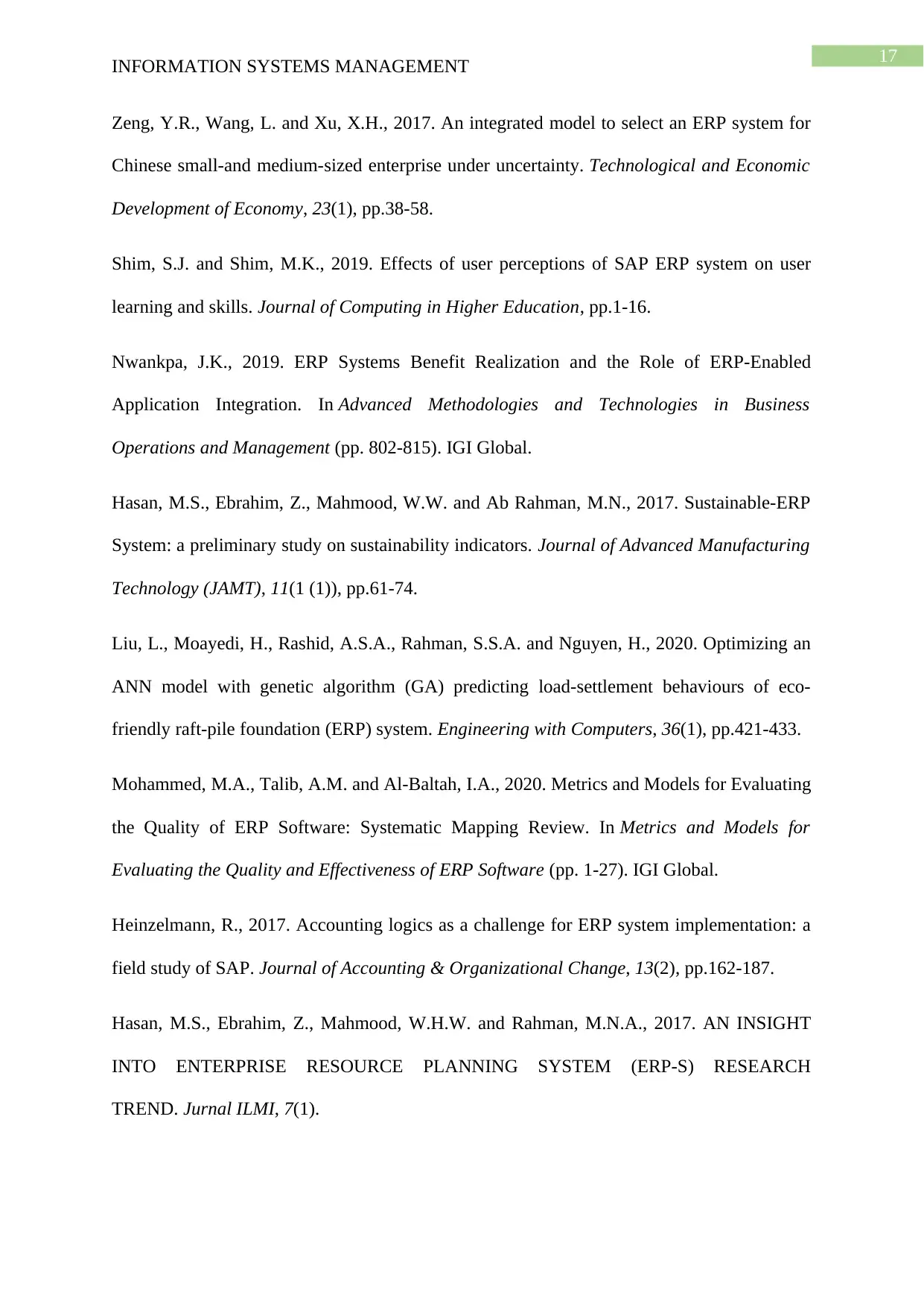
17
INFORMATION SYSTEMS MANAGEMENT
Zeng, Y.R., Wang, L. and Xu, X.H., 2017. An integrated model to select an ERP system for
Chinese small-and medium-sized enterprise under uncertainty. Technological and Economic
Development of Economy, 23(1), pp.38-58.
Shim, S.J. and Shim, M.K., 2019. Effects of user perceptions of SAP ERP system on user
learning and skills. Journal of Computing in Higher Education, pp.1-16.
Nwankpa, J.K., 2019. ERP Systems Benefit Realization and the Role of ERP-Enabled
Application Integration. In Advanced Methodologies and Technologies in Business
Operations and Management (pp. 802-815). IGI Global.
Hasan, M.S., Ebrahim, Z., Mahmood, W.W. and Ab Rahman, M.N., 2017. Sustainable-ERP
System: a preliminary study on sustainability indicators. Journal of Advanced Manufacturing
Technology (JAMT), 11(1 (1)), pp.61-74.
Liu, L., Moayedi, H., Rashid, A.S.A., Rahman, S.S.A. and Nguyen, H., 2020. Optimizing an
ANN model with genetic algorithm (GA) predicting load-settlement behaviours of eco-
friendly raft-pile foundation (ERP) system. Engineering with Computers, 36(1), pp.421-433.
Mohammed, M.A., Talib, A.M. and Al-Baltah, I.A., 2020. Metrics and Models for Evaluating
the Quality of ERP Software: Systematic Mapping Review. In Metrics and Models for
Evaluating the Quality and Effectiveness of ERP Software (pp. 1-27). IGI Global.
Heinzelmann, R., 2017. Accounting logics as a challenge for ERP system implementation: a
field study of SAP. Journal of Accounting & Organizational Change, 13(2), pp.162-187.
Hasan, M.S., Ebrahim, Z., Mahmood, W.H.W. and Rahman, M.N.A., 2017. AN INSIGHT
INTO ENTERPRISE RESOURCE PLANNING SYSTEM (ERP-S) RESEARCH
TREND. Jurnal ILMI, 7(1).
INFORMATION SYSTEMS MANAGEMENT
Zeng, Y.R., Wang, L. and Xu, X.H., 2017. An integrated model to select an ERP system for
Chinese small-and medium-sized enterprise under uncertainty. Technological and Economic
Development of Economy, 23(1), pp.38-58.
Shim, S.J. and Shim, M.K., 2019. Effects of user perceptions of SAP ERP system on user
learning and skills. Journal of Computing in Higher Education, pp.1-16.
Nwankpa, J.K., 2019. ERP Systems Benefit Realization and the Role of ERP-Enabled
Application Integration. In Advanced Methodologies and Technologies in Business
Operations and Management (pp. 802-815). IGI Global.
Hasan, M.S., Ebrahim, Z., Mahmood, W.W. and Ab Rahman, M.N., 2017. Sustainable-ERP
System: a preliminary study on sustainability indicators. Journal of Advanced Manufacturing
Technology (JAMT), 11(1 (1)), pp.61-74.
Liu, L., Moayedi, H., Rashid, A.S.A., Rahman, S.S.A. and Nguyen, H., 2020. Optimizing an
ANN model with genetic algorithm (GA) predicting load-settlement behaviours of eco-
friendly raft-pile foundation (ERP) system. Engineering with Computers, 36(1), pp.421-433.
Mohammed, M.A., Talib, A.M. and Al-Baltah, I.A., 2020. Metrics and Models for Evaluating
the Quality of ERP Software: Systematic Mapping Review. In Metrics and Models for
Evaluating the Quality and Effectiveness of ERP Software (pp. 1-27). IGI Global.
Heinzelmann, R., 2017. Accounting logics as a challenge for ERP system implementation: a
field study of SAP. Journal of Accounting & Organizational Change, 13(2), pp.162-187.
Hasan, M.S., Ebrahim, Z., Mahmood, W.H.W. and Rahman, M.N.A., 2017. AN INSIGHT
INTO ENTERPRISE RESOURCE PLANNING SYSTEM (ERP-S) RESEARCH
TREND. Jurnal ILMI, 7(1).
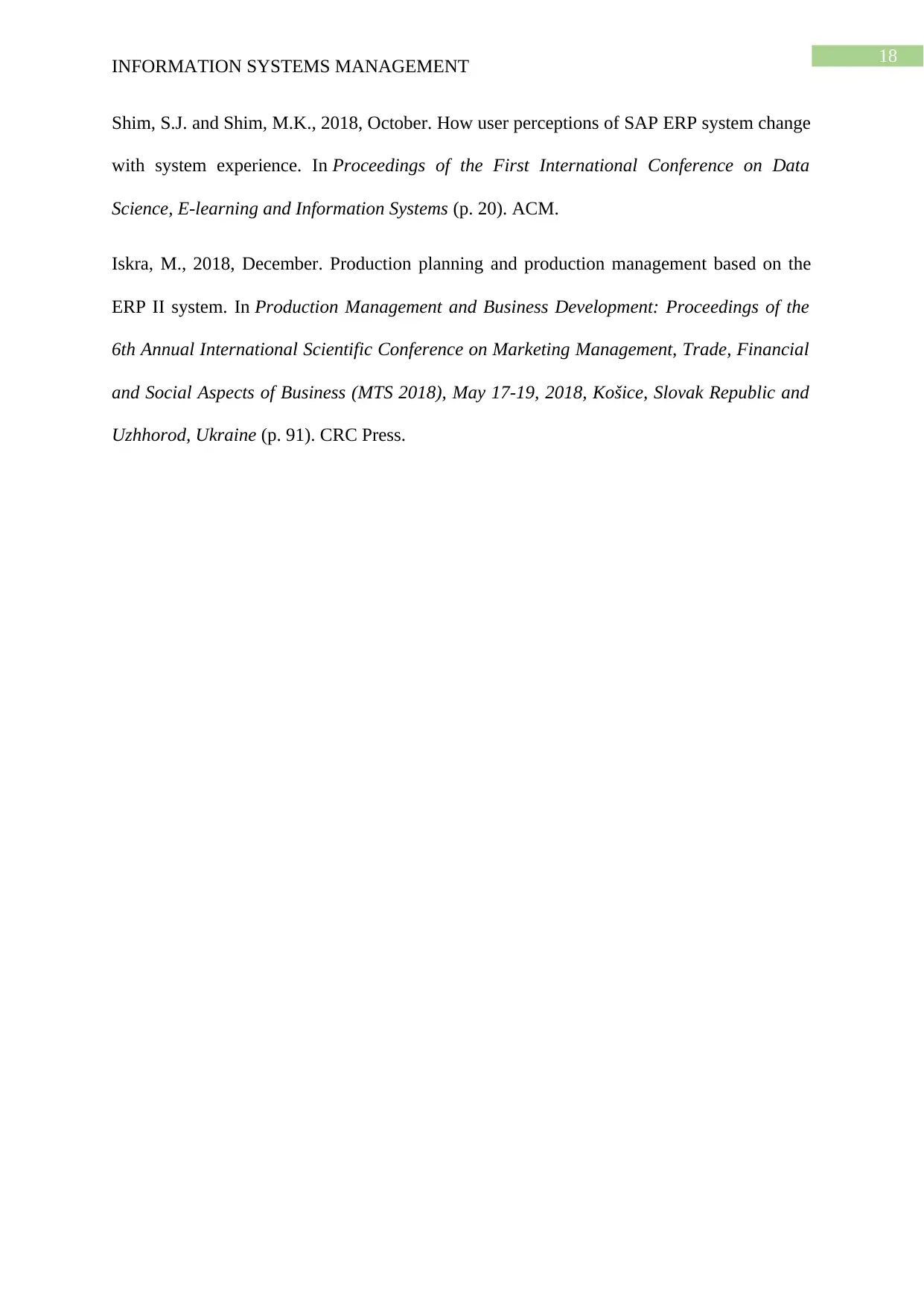
18
INFORMATION SYSTEMS MANAGEMENT
Shim, S.J. and Shim, M.K., 2018, October. How user perceptions of SAP ERP system change
with system experience. In Proceedings of the First International Conference on Data
Science, E-learning and Information Systems (p. 20). ACM.
Iskra, M., 2018, December. Production planning and production management based on the
ERP II system. In Production Management and Business Development: Proceedings of the
6th Annual International Scientific Conference on Marketing Management, Trade, Financial
and Social Aspects of Business (MTS 2018), May 17-19, 2018, Košice, Slovak Republic and
Uzhhorod, Ukraine (p. 91). CRC Press.
INFORMATION SYSTEMS MANAGEMENT
Shim, S.J. and Shim, M.K., 2018, October. How user perceptions of SAP ERP system change
with system experience. In Proceedings of the First International Conference on Data
Science, E-learning and Information Systems (p. 20). ACM.
Iskra, M., 2018, December. Production planning and production management based on the
ERP II system. In Production Management and Business Development: Proceedings of the
6th Annual International Scientific Conference on Marketing Management, Trade, Financial
and Social Aspects of Business (MTS 2018), May 17-19, 2018, Košice, Slovak Republic and
Uzhhorod, Ukraine (p. 91). CRC Press.
1 out of 19
Related Documents
Your All-in-One AI-Powered Toolkit for Academic Success.
+13062052269
info@desklib.com
Available 24*7 on WhatsApp / Email
![[object Object]](/_next/static/media/star-bottom.7253800d.svg)
Unlock your academic potential
© 2024 | Zucol Services PVT LTD | All rights reserved.




